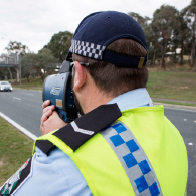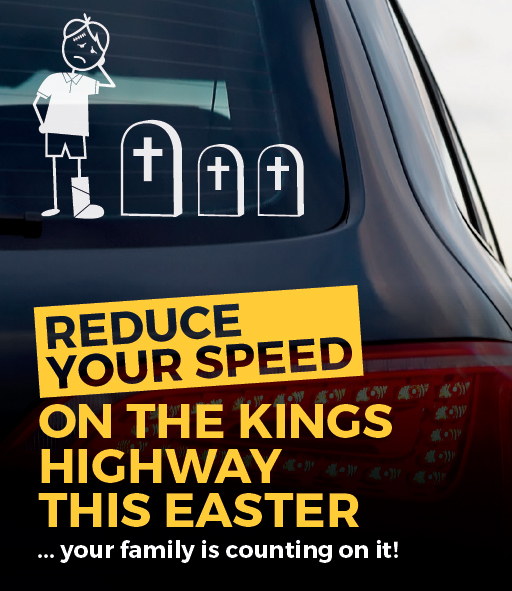ACT Policing: Annual Report 2018-19
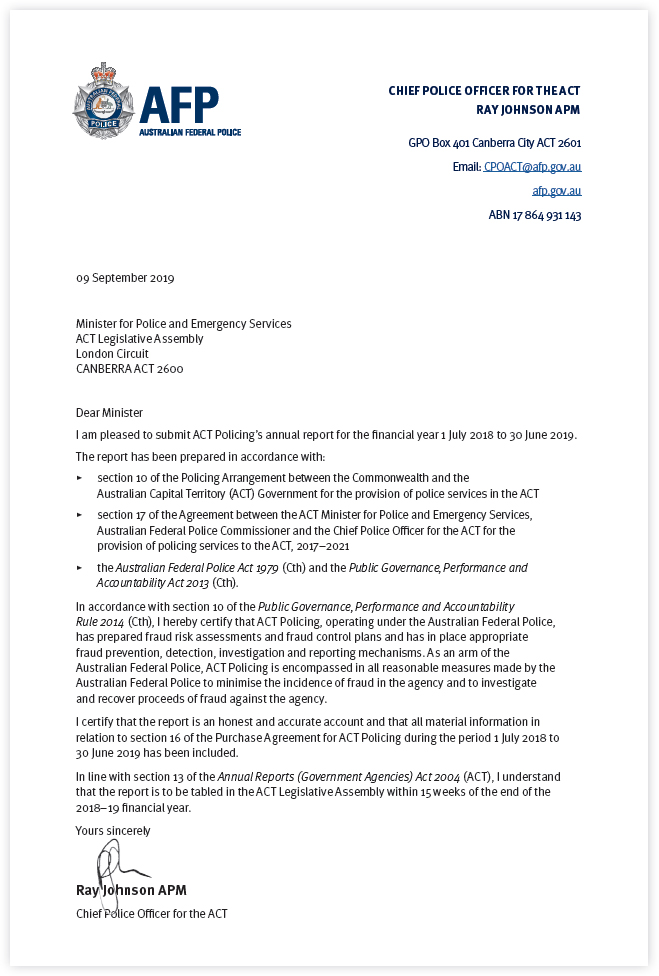
Contents
- 1 Chief Police Officer’s foreword
- 2 Ministerial Direction
- 3 ACT Policing at a glance
- 4 Performance analysis
- 5 Professional standards
- 6 Use of force
- 7 Staffing profile
- 8 Financials
- Appendices
- Appendix 1: Financial Statements
- Appendix 2: Statement of Performance
- Appendix 3: Number of offences reported and cleared in PROMIS case write-off module - 1 July 2014 to 30 June 2019
- Appendix 4: Offences cleared by ACT Policing in the Australian Capital Territory 2014-15 to 2018-19
- Appendix 5: Percentage of offences cleared by ACT Policing 2014-15 to 2018-19
- Appendix 6: Proceedings against offenders by ACT Policing (charges) 2014-15 to 2018-19

Artist: Zita Pengarte Wallace
Dreaming: Ulumba “Rain” awele-awele “Bush Tomato”
1 Chief Police Officer’s foreword

Chief Police Officer for the ACT Ray Johnson APM
My first year as Chief Police Officer for the ACT has been busy, challenging, productive and highly rewarding. It is a privilege to lead the extraordinary team of people that make up ACT Policing who dedicate themselves to the safety and security of the ACT community, our community, every day.
Despite our history of high performance, policing is not short of challenges, with the complexity of the criminal environment increasing to meet the opportunities presented by the modern world. Policing is also expected to keep pace with communities, evolving to meet the opportunities provided by technology, greater connectivity, global and diverse business opportunities, and the challenges provided by ever more complex social issues. This means we need to be as effective and efficient as possible, something we can only do in collaboration with our partners — both government and non-government, the private sector and the community itself. The police are only one part of a system of community support and protection.
This year has seen ACT Policing utilise advances in tools and technology with the roll-out of mobile capabilities such as Mobile Responder, a platform that provides operational members real-time access to details of incidents and resource deployments while in the field.
These enhancements have enabled ACT Policing to continue to perform strongly in the face of increasing demand, achieving 15 of the 21 Performance Measures and 13 out of 17 Indicators of Effectiveness during 2018-19.
In order to continue our development, the ACT Government has invested $33.9 million in ACT Policing to start moving to a more mobile and agile service model. This is a long-term strategic investment in both ACT Policing and in our community, which will see ACT Policing focus more on crime disruption, crime prevention, community engagement and problem-solving activities to harden our community to the effects of crime and disorder and to reduce response calls whilst still responding effectively when needed.
Over the next four years, we will see the recruitment of over 60 new ACT Policing operational and support staff, the adoption of forward-thinking, community-focused policing strategies and increased digital engagement in order to give people better access to policing services.
While we continue to look toward the future, it is important that we recognise what we have achieved in the 2018-19 period. Through the ACT Policing Futures Program, we have provided our police members with upgraded Conducted Electrical Weapons linked to new Body Worn Cameras. This new technology has improved the ability of our members to respond to the challenges of modern policing and ensures that we are capturing the best evidence possible at the time.
ACT Policing has continued to work closely with the ACT Government and other partner agencies to maintain and improve community safety and reduce crime in the ACT. These partnerships have enabled us to enforce new and innovative crime disruption techniques while maximising opportunities to divert youth and vulnerable groups away from the criminal justice system.
We continue to work towards improving outcomes for the Aboriginal and Torres Strait Islander community and support the visions of the ACT Aboriginal and Torres Strait Islander Agreement 2019-2028. This year has seen the establishment of the Chief Police Officer’s Advisory Board and a focus on providing our members with enhanced cultural knowledge and skills to improve police-Aboriginal and Torres Strait Islander community connections. This program focuses on the benefits of early engagement and consultation and assists with practical information regarding matters such as the use of language and the importance of culture to Aboriginal and Torres Strait Islander communities. We acknowledge that there is still a lot of work to do and we will continue to work with our partners and the community to improve outcomes.
ACT Policing continues to take the profit out of organised crime, with 2018-19 proving to be a significant year in our efforts to disrupt criminal gangs and the trade of illicit drugs. This past year saw ACT Policing’s two largest cocaine seizures connected with organised crime, with a combined 384 kilograms of cocaine removed from the street and crime syndicate members arrested. These seizures held a street value of approximately $144 million.
Further successes were seen in Operation Ghar which targeted the supply of illicit substances in Canberra’s entertainment districts and saw the arrest of four people on a cumulative 21 charges and the seizure of significant amounts of cash and illicit substances.
ACT Policing, along with our partners, continues to disrupt and deter the growth of criminal gangs in the face of ongoing rivalry between these gangs. Through Taskforce Nemesis, 2018-19 has seen 34 members of criminal motorcycle gangs arrested, the execution of 53 search warrants, the seizure of 21 firearms and the laying of 107 charges relating to criminal gang activity. Criminal gangs continue to seek to cause harm in our community. ACT Policing remains committed to the targeted detection and disruption of these gangs and the apprehension of those who elect to support their activities.
We continued to see positive results in the fight against the cycle of family violence. The ‘pro-intervention’ approach to breaking the cycle of violence has seen a significant increase in the number of Family Violence Orders and Personal Protection Orders served in 2018-19, with 2005 Family Violence Orders and 1432 Personal Protection Orders served. ACT Policing has seen encouraging progress with the Family Violence Early Intervention Program, which facilitates early engagement with support services for persons who use, or are at risk of using, violence in their family. This program aims to reduce the risk of further family violence incidents in the future and supports ACT Policing’s commitment to early intervention in preventing family violence and other crime types.
Ensuring the safety for vulnerable road users has remained a priority for ACT Policing and Government. Through 2018-19 and into the coming year, ACT Policing continues to work with our community to learn from the past and improve our road use. Working closely with government, community groups and our community, ACT Policing continues to educate motorists, enforce traffic laws and improve the safety of all road users. While it is pleasing to see a reduction in road fatalities in the past 12 months, there is more work to do — even one death on our roads is one too many.
While this annual report provides us with an opportunity to examine the performance and results achieved by ACT Policing, it is important that we remember the efforts and commitment of the members who helped achieve these results. As first responders, our members operate day-to-day, assisting people at their most vulnerable and regularly experience confronting situations. I recognise the many challenges of the community policing environment and the toll that this can take on our members. I am committed to ensuring the physical and mental wellbeing of all members of ACT Policing. We continue to explore new ways of providing support and easing the pressures on a workforce that is under constant pressure to get the job done. Through initiatives such as Lifeline Canberra’s Road to Mental Readiness Course, we are working to equip our members with the strategies and tools necessary to identify and address mental health concerns earlier.
As we begin the transition to a new community-focused model of policing, the importance of working in partnership with our community and stakeholders is as significant as ever. With the ongoing support and confidence of government and the ACT community, ACT Policing remains committed to delivering a quality service to our community and to making Canberra an even safer place to live.
Ray Johnson APM
Chief Police Officer for the ACT
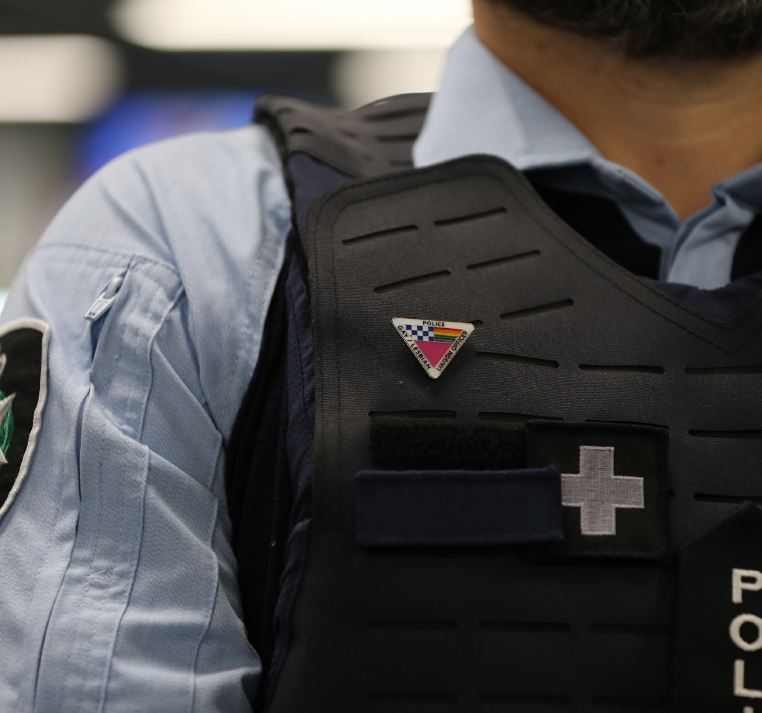
2 Ministerial Direction
Minister for Police and Emergency Services Ministerial Direction

Minister for Police and Emergency Services Ministerial Direction
This Direction is issued under section 7 of the Policing Arrangement between the Commonwealth and Australian Capital Territory (ACT) Governments and outlines the Government’s priorities and expectations for the Australian Federal Police (AFP) and more specifically the Chief Police Officer for the ACT (CPO).
This Direction is to be read in conjunction with the 2017-2021 Purchase Agreement between the ACT Minister for Police and Emergency Services, the AFP Commissioner and the Chief Police Officer. It supersedes and revokes the Direction issued on 29 June 2016.
The ACT Government is committed to effective delivery of its policies. ACT Policing will play a key role in implementing the Government’s policies to tackle crime, both through its operations and its ongoing collaboration with the Justice and Community Safety Directorate and the broader ACT Government, non-government organisations and other stakeholders, including Commonwealth and other State and Territory jurisdictions, in realising the vision and objectives of ACT Government strategies.
I note that the responsibilities and expectations of ACT Policing by government and the community are evolving. I expect that, in addition to the below special areas of focus, ACT Policing will continue to prepare and respond appropriately to changes in the national security and threat environment and, through an enhanced focus on technology and innovation, will develop agile policing capabilities that are able to respond to increasingly complex and emerging crime, including serious and organised crime.
ACT Policing delivers a professional, innovative and effective policing service in a dynamic environment for all the people of the ACT. |
Special Areas of Focus
The Government expects ACT Policing will focus its activities on the following key strategic priorities:
- Strengthening ACT’s response to domestic and family violence in appropriate and culturally sensitive ways; and supporting the efforts of the Coordinator-General for Family Safety.
- Working proactively and innovatively with Government to reduce and prevent alcohol-fuelled violence including enforcing liquor laws, maintaining a presence in night entertainment precincts and responding to alcohol related violent incidents.
- Continuing the commitment to early intervention and diversion strategies including restorative justice with a focus on vulnerable groups, in particular young people and Aboriginal and Torres Strait Islander peoples.
- Improving road safety through particular emphasis on vulnerable road users and combating anti-social and dangerous behaviours including speeding, driving while impaired or distracted
- Continue to focus on preventing, disrupting and responding to the evolving threat of violent extremism and terrorism with a particular focus on crowded places.
In support of these, I expect ACT Policing will continue to demonstrate accountability and responsiveness. I encourage ACT Policing to continue to build a diverse and inclusive workforce that is committed to the wellbeing and health of its people.
ACT Policing delivers a professional, innovative and effective policing service in a dynamic environment for all the people of the ACT. I will continue to work with ACT Policing in ensuring it can provide the systems, technology and capabilities that can drive continuous improvement and allow for new and innovative policing approaches.
Mick Gentleman, MLA
Minister for Police and Emergency Services
10 July 2017
3 ACT Policing at a glance

Our Role
Through a Purchase Agreement with the Australian Federal Police (AFP), ACT Policing is responsible for providing quality and effective policing services to the people of the Australian Capital Territory (ACT). We do this in partnership with the community and the ACT Government.
Our Mission
Our mission is to keep the peace and preserve public safety within the ACT.
Our Governance
The key documents which govern the delivery of policing services to the ACT are the Policing Arrangement, Purchase Agreement and Ministerial Direction.
Policing Arrangement
The AFP is a statutory authority established by the Federal Parliament under the Australian Federal Police Act 1979 (Cth). The AFP delivers policing services to the ACT as a separate outcome under a contractual arrangement between the Commonwealth and the ACT Government.
Purchase Agreement
The Policing Arrangement provides for the negotiation of a Purchase Agreement between the AFP and the ACT Government. The Agreement details the outputs, performance measures, targets, facilities and outcomes to be provided, as well as the powers and obligations of the Minister for Police and Emergency Services and the Chief Police Officer for the ACT, along with associated administrative arrangements.
The Purchase Agreement defines the three main outcomes against which ACT Policing’s performance is measured:
- Reduce Crime
- Public Safety
- Community and Partner Engagement
Ministerial Direction
The Ministerial Direction outlines the ACT Government’s priorities for, and expectations of, the Australian Federal Police and the Chief Police Officer for the ACT (see Chapter 2: 2017-18 Ministerial Direction).
Further details of the Policing Arrangement, the Purchase Agreement and the Ministerial Direction are available via ACT Policing’s website at: police.act.gov.au/about-us/government-directions.
Our Intent
We strive to deliver a professional, innovative and effective policing service in an ever changing environment for the ACT community.
Our Values
We pride ourselves on being a values-driven organisation. Our core values of integrity, commitment, excellence, accountability, fairness, respect and trust represent our principles and standards — the values we uphold in performing our professional duties.
Our Budget
Under the Purchase Agreement the funding provided by the ACT Government to the AFP for delivery of policing services in 2018-19 was $166.279 million.
The total price includes enabling costs and direct funding from the Justice and Community Safety Directorate for crime prevention initiatives
(see Chapter 8: Financial Management Reporting).
Our Approach
Our approach is underpinned by a series of strategies and initiatives that support the outcomes set out in the Performance Measure Framework.
Reduce Crime
- Continued support against the ACT Property Crime Prevention Strategy 2016-2020, by promoting innovative and enduring crime prevention strategies and reducing the opportunities for crime to occur or recur.
- Enhancing our response to, and the investigation of, offences by forging strong relationships with stakeholders to facilitate whole-of-government and cross-jurisdictional information sharing and collaboration.
- Applying technology and forensic science capabilities and effectively using intelligence from a wide range of sources.
- Providing effective and efficient support to the judicial process by maintaining a robust partnership with the ACT Director of Public Prosecutions and delivering high standard briefs in a timely manner.
- Facilitating a more efficient criminal justice system with emphasis on timely preventive justice measures and judicial processes.
Public Safety
- Responding in accordance with community expectations, ensuring resources meet demands and enhancing police responsiveness through mobility solutions.
- Effectively planning and managing major events and public demonstrations by reviewing and improving existing arrangements, working with the community and relevant agencies and conducting post-operational assessments for continuous improvement and better practice.
- Working with partners to develop and maintain preparedness in response to emergencies and disasters.
- Improving and promoting road safety through education, innovation and targeted enforcement by working with partner agencies, supporting the ACT Road Safety Strategy and Action Plan and maintaining targets to align with the ACT Road Safety Calendar.
Community and Partner Engagement
- Increasing community trust and confidence in police by communicating in innovative ways with the community, maintaining a social media presence and collaborating with partner agencies, business and community groups to support community events.
- Increasing support for early intervention and diversion by working with partner agencies and community groups to prevent and reduce recidivism.
- Continuing support and delivery in line with the new ACT Aboriginal and Torres Strait Islander Agreement 2019-2028 to prevent and reduce the number of Aboriginal and Torres Strait Islander peoples coming into contact with the criminal justice system.
- Supporting the National Plan to Reduce Violence against Women and their Children 2010-2022 and further initiatives that deter, detect and prevent violence against women and children.
- Enhancing and strengthening the resilience of communities through safety and security initiatives and building relationships with vulnerable community groups.
Our Performance
ACT Policing’s performance is measured by the Performance Measure Framework which incorporates three major outcomes and a series of strategies, initiatives and targets as articulated in the 2017-21 Purchase Agreement.
The overarching budgetary outcome of the Purchase Agreement is to work in partnership with the community to create a safer and more secure ACT through the provision of quality policing services. The Performance Measure Framework aims to enhance accountability for the delivery of services and provide clear links between ACT Policing’s outcomes, outputs, strategies and individual measures.
ACT Policing’s three outcomes (Reduce Crime, Public Safety, Community and Partner Engagement) are supported by 21 Performance Measures and 17 Indicators of Effectiveness.
Additional information and results on Performance Measures and the Indicators of Effectiveness are further described in Chapter 4: Performance Analysis.
Our Challenges
Major challenges and demands presented to ACT Policing during 2018-19 included:
- Crime and recidivism — The reduction of crime in the community and the targeting of recidivism through early intervention and community engagement.
- Family violence — Taking a broad approach with the ACT Government and our partner agencies to combat the cycle of family violence and reinforce the support services available to victims.
- Alcohol-fuelled violence — Continuing to collaborate with stakeholders and support services to prevent and reduce anti-social behaviour and alcohol-fuelled violence, enforcing liquor laws and responding to incidents within entertainment precincts.
- Evolving crime environment — Ongoing development of agile policing capabilities to respond to crime, recognising the growing complexities of the crime environment.
- Serious and organised crime — The prevention and disruption of serious and organised crime with a focus on targeting, disrupting and apprehending members of criminal gangs and seizing associated wealth derived from criminal activity.
- Reducing the over-representation of Aboriginal and Torres Strait Islander peoples in the justice system — Ongoing engagement with the local communities to further develop solid, trusting relationships through open dialogue, evolving our understanding of the challenges faced by Aboriginal and Torres Strait Islander peoples.
- Protecting ACT Policing — Increasing the personal safety of ACT Policing officers who are regularly exposed to a risk of assault and/or injury while on duty.
- Increased demand — Canberra’s growth continues to bring an increased demand on policing services. In the last five years there has been more than a 30 per cent increase in critical and time-sensitive calls requiring urgent police attendance.
- Establishing an inclusive workforce — Developing a more flexible and professional workforce that is committed to health and wellbeing and increasing diversity across ACT Policing.
- Preparing ACT Policing for the future — In order to address the needs of the growing ACT community we continue to work on the ACT Futures Program to ensure that we deliver a sustainable, efficient and effective police service which will meet the current and long-term needs of the ACT community.
Our People
The Chief Police Officer (CPO) is accountable to the ACT Minister for Police and Emergency Services for the achievements and outcomes set out in the Purchase Agreement and Ministerial Direction.
The CPO is also responsible for the management of personnel and resources used to deliver police services to the ACT community. The CPO is supported by three functional streams: Crime, Response and Corporate Services.
Information about ACT Policing personnel can be found in Chapter 7: Staffing Profile.
FIGURE 3.1: ACT POLICING ORGANISATIONAL STRUCTURE AS AT 30 JUNE 2019
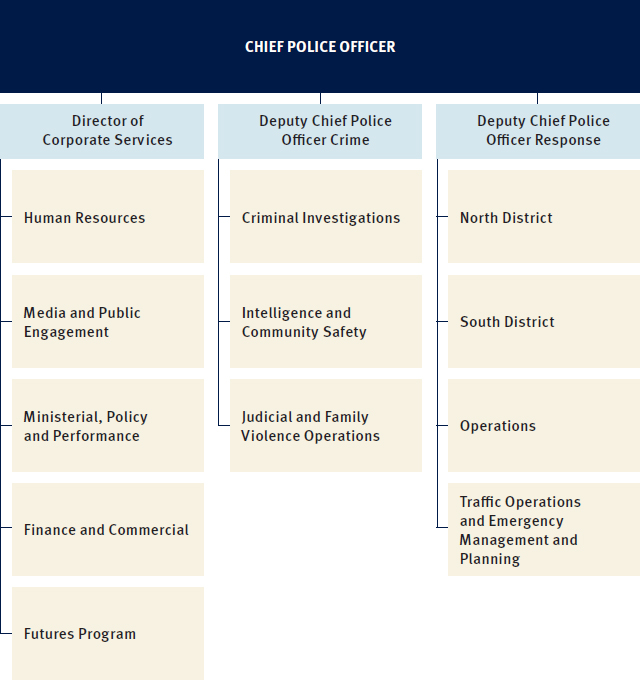
FIGURE 3.2: ACT POLICING PATROL ZONES AS AT 30 JUNE 2019
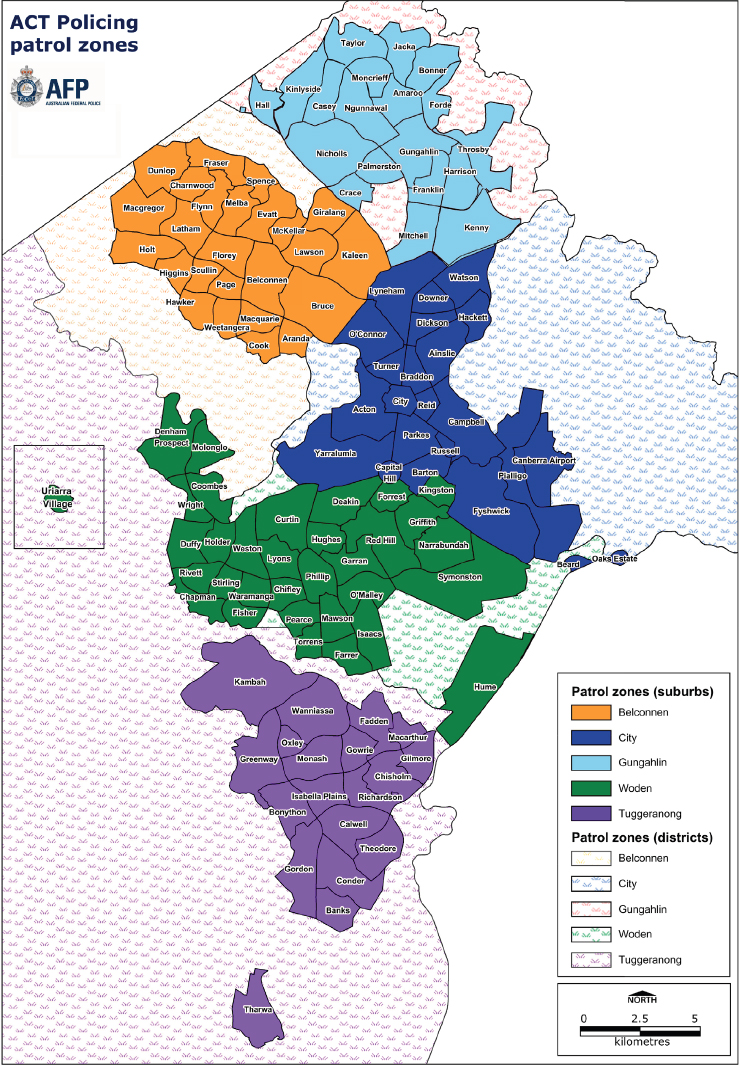
Our Future
The ACT Policing Futures Program is ensuring that ACT Policing is ready to deliver a sustainable, efficient and effective policing service to meet the current and long-term needs of the ACT community. The program was launched in mid-2017 and continues to ensure our workforce is best equipped to serve the ACT community now and into the future.
The program is continually examining our workforce readiness through five pillars:
- Process and Governance — Establishing a streamlined governance framework that is succinct, relevant and accessible, supports our business and enables interoperability with partner agencies.
- People and Training — Developing recruitment, training, career development and retention frameworks that reflect and support a professional, dynamic and diverse workforce.
- Tools and Technology — Using contemporary, adaptable and responsive technology solutions that are effective, functional and enhance policing outcomes.
- Logistics and Facilities — Providing accommodation facilities which are fit for purpose, in the right locations, support mobility and enable a dynamic and effective response to the needs of the ACT community.
- Information — Ensuring information management and communication practices are concise, direct and provide relevant information in an appropriate, timely and consistent manner.
In May 2019, the ACT Government announced funding for $33.9m for ACT Policing to move towards a new community-focused model of policing. This includes funding for over 60 additional operational and support staff over the next four years.
Through operationalising intelligence, building proactive policing capacity and growing community engagement capabilities, this long-term strategic investment will see ACT Policing and our community into the future.
During the 2018-19 financial year, the Futures Program also delivered a number of short-term initiatives, including:
- The roll out of upgraded Conducted Electrical Weapons linked to new Body Worn Cameras for our operational members which provide significantly enhanced recording and functionality.
- An ACT Policing Crime Trends and Performance Dashboard developed to inform, in real time, all levels of ACT Policing (from executive to frontline) on emerging issues, crime trends and operational performance on a daily basis.
- The ACT Policing Mobile Responder pilot, which provides operational members with real-time access to details of Computer Aided Dispatch incidents while in the field. It is currently nearing the end of its trial and plans are underway to roll out to ACT Policing in the near future. This will enable officers to be more flexible, mobile and dynamic in their approach to policing the ACT.
Case study
Providing the systems, technology and capabilities that can drive continuous improvement and allow for new and innovative policing approaches. ACT Policing Futures Program — Body Worn Camera roll out In March 2019, the ACT Policing Futures Program led the roll-out of upgraded Conducted Electrical Weapons (CEW) and new Body Worn Cameras (BWC) to ACT Policing members as part of ACT Policing’s commitment to ensuring the safety of both officers and the public, as well as having access to the best tools and technology. This technology provides new levels of recording and functionality, ensuring transparency and accountability and providing the best evidence for the courts. By the end of the 2018-19 financial year, more than 369 members received the upgraded CEW and new BWC technology, thanks to a $2.695 million investment from the ACT Government over four years. Approximately 114 members are still to undergo training before the roll-out is complete. ACT Policing is always looking at improved techniques to best utilise the tools available to us and to improve the safety of both police and the public. ACT Policing will continue to work with government, stakeholders and the public to make best use of the technology to keep the community safe. In 2018-19, ACT Policing was called to a violent disturbance at a residence in Canberra. On arrival police were approached by a male who was aggressive, intoxicated and carrying a knife. Advancing on police, the male threatened to use the knife. Attending police drew and aimed their CEWs and began negotiations with the male. Recognising that police had CEWs, the male dropped the knife and was arrested without incident. Video footage from the BWC, which commenced recording automatically, later proved invaluable to police investigating the incident and the Court.
|
4 Performance analysis
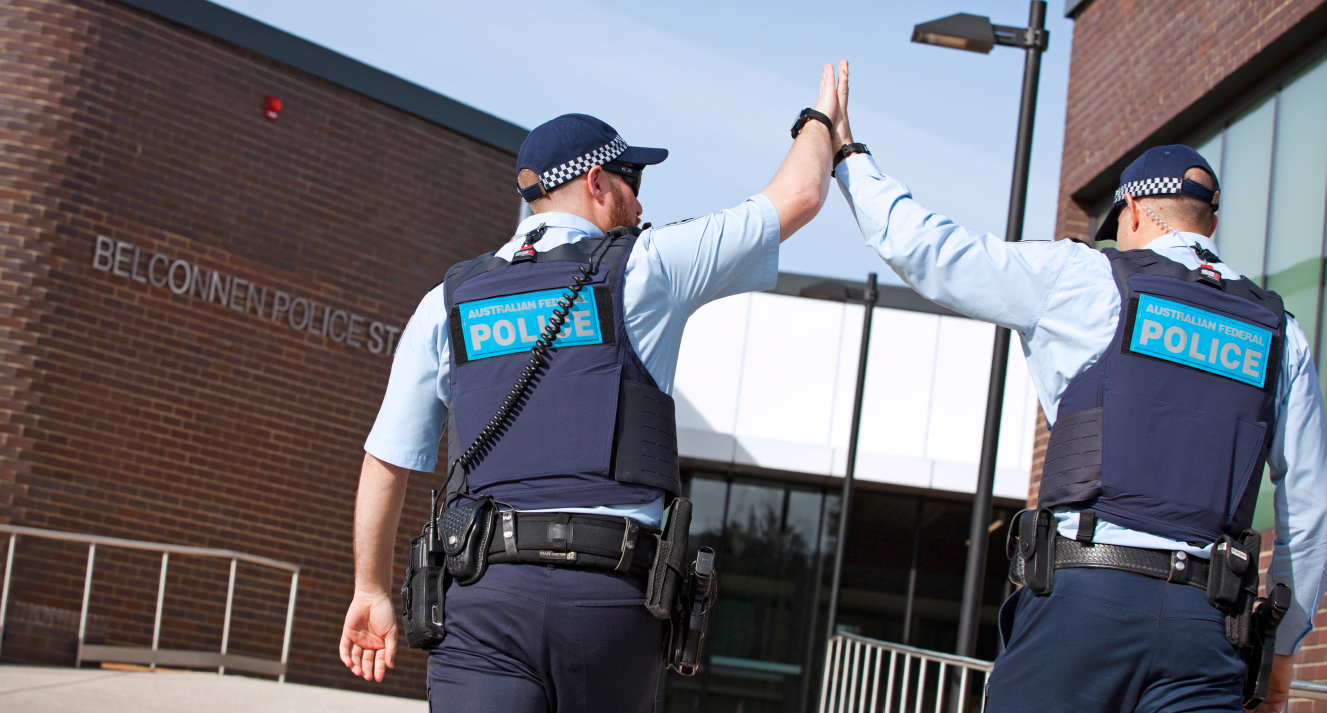
2018-19
COMMUNITY POLICING 30.7K Triple Zero calls 3232 arrests made 2628 family violence incidents attended 2213 summons 874 intoxicated persons lodged in custody 325 cautions issued |
INTERVENTION 6065 referrals to community support agencies 1226 drug seizures 167 people diverted into Early Intervention and Drug Diversion Program 137 number of diversionary conferences |
ORDERS AND BRIEFS 2005 Family Violence Orders 1432 Personal Protection Orders 1086 hearing briefs delivered to DPP |

COMMUNITY ENGAGEMENT 1240 media enquiry responses provided 420 media releases issued |
ACT POLICING WEBSITE 407K unique page views for police.act.gov.au 1.2M unique page views for policenews.act.gov.au
|
SOCIAL MEDIA 116.9K followers on Facebook 59.5K followers on all Twitter channels (ACT Policing, CKK, CPO ACT, ACT_Pol Traffic) 53.4M impressions on Facebook 6.4M impressions on all Twitter channels |
CONSTABLE KENNY KOALA PROGRAM 1152 classrooms visited 25.5K students visited 46 community events attended 201.5K impressions on Constable Kenny Twitter |
Note: Impressions are the number of times a post from your page is displayed, no matter if it was clicked on/engaged with or not. For example, if someone sees a page update in their Facebook newsfeed and then sees that same update when a friend shares it, that would count as two impressions.
ACT Policing, in partnership with the ACT Government and the community, aims to create a safer and more secure ACT through the provision of a quality community policing service.
The Purchase Agreement outlines 21 Performance Measures under three main outcomes against which ACT Policing’s performance is measured.
Outcome | Outputs |
|---|---|
Reduce Crime | Crime Prevention and Reduction |
Criminal Investigations and Prosecutions | |
Public Safety | Police Response |
Public Order and Emergency Management | |
Road Safety and Traffic Management | |
Community and Partner Engagement | Community Support and Whole-of-Government Collaboration |
The Purchase Agreement also outlines 17 Indicators of Effectiveness that measure public perceptions of crime, public confidence in police, road safety and crime prevention through the National Survey of Community Satisfaction with Policing.
A full summary of all offences reported and cleared by ACT Policing in addition to the number of proceedings against offenders by ACT Policing can be found at Appendices 3 to 6.
Performance Measures
ACT Policing achieved or exceeded 15 of the 21 Performance Measures and 13 of the 17 Indicators of Effectiveness (IoE) set out in the Purchase Agreement.
Community satisfaction and confidence in ACT Policing remains high and above the national average, as referenced in the outcomes of the IoE.
Indicators of Effectiveness
The IoE framework was introduced in the 2014-15 Purchase Agreement to separate the indicators contained within the framework from the Performance Measures Framework. This recognises that the performance outcomes for these indicators are not fully within ACT Policing’s control. There are a number of public and private institutions and individuals who contribute to the results of these indicators.
The National Survey of Community Satisfaction with Policing (NSCSP) is a telephone survey (landline and mobile telephone numbers) which measures community perceptions of a range of policing-related issues. These issues include satisfaction with policing services, feelings of safety, concern about potential victimisation and beliefs about police behaviour. During 2018-19, 2400 ACT residents participated in the survey with 28,048 participating nationally. This survey relates to 17 IoEs and two Performance Measures.
The survey monitors community concern about becoming a victim of certain crime types. While these series of questions can elicit a variety of interpretations, ranging from an assessment of likelihood of victimisation through to an assessment of how the victim would feel if they were to become a victim, the indicators are the best available for fear of crime.
It is important to note that while we aim to reduce the level of fear of crime, there are positive aspects to the community having some level of awareness of crime in their neighbourhood. A level of awareness can contribute to crime prevention behaviours and potentially lower the chances of victimisation.
ACT Policing undertakes education and crime prevention strategies and works with community organisations to educate members of the community on personal and property safety and measures that can be put in place to mitigate the risk of becoming a victim of crime. This, in turn, provides reassurance and reduces the level of fear in the community.
The NSCSP results relevant to the IoE for 2018-19 can be found in Appendix 2.
The following data provides an overview of each Performance Measure against the 2018-19 targets, the achieved result and the reason for variation, if any.
Data for the selected Performance Measures and comparison tables was extracted from ACT Policing’s case management system (PROMIS) on 2 July 2019. It is important to note that ACT Policing’s database is live and data is continually revised, therefore statistics may differ depending on the date of extraction.

Outcome: Reduce Crime
Crime Prevention and Reduction
Performance Measure 1 — Number of offences against the person reported or becoming known per 100,000 population.
Offences against the person include, but are not limited to, homicide and related offences, sexual assault offences, assault offences and other offences against the person (including kidnapping and abduction, threatening behaviour and other dangerous and negligent acts).
The target for this measure was 800 or less offences against the person reported or becoming known per 100,000 population. ACT Policing did not meet the target for this measure, recording a result of 894 offences per 100,000 population, over the target by 11.7 per cent.
FIGURE 4.1: OFFENCES REPORTED AGAINST THE PERSON 2009-10 TO 2018-19

Source: PROMIS as at 2 July 2019
*Other offences against the person include kidnapping and abduction, threatening behaviour and other dangerous and negligent acts.
During 2018-19, there were 3668 offences against the person reported to ACT Policing. This represents an increase of 2.6 per cent (or 94 offences), compared to 2017-18.
TABLE 4.1: OFFENCES AGAINST THE PERSON BY OFFENCE TYPE — FINANCIAL YEAR COMPARISON
Offences type | 2017-18 | 2018-19 | Change (%) |
|---|---|---|---|
Homicide and related offences | 11 | 7 | -36.4% |
Sexual Assault offences | 500 | 548 | 9.6% |
Assault | 2837 | 2830 | -0.2% |
Assault (Other) | 1595 | 1577 | -1.1% |
Assault (Home) | 1242 | 1253 | 0.9% |
Other offences against person* | 226 | 283 | 25.2% |
Total | 3574 | 3668 | 2.6% |
Source: PROMIS as at 2 July 2019
*Other offences against the person include kidnapping and abduction, threatening behaviour and other dangerous and negligent acts.
During 2018-19, assault offences decreased by 0.2 per cent overall when compared to 2017-18. Despite this decrease, 39.9 per cent of all assaults reported to ACT Policing were family violence-related as demonstrated in Figure 4.2.
While family violence-related assaults have decreased by 4.2 per cent over the past 12 months, long-term trends show an increase of 38.7 per cent over the past 10 years. Traditionally, incidents of family violence have been under-reported and the increase of family violence-related assaults may reflect a cultural shift in a willingness to report.
FIGURE 4.2: PROPORTION OF FAMILY VIOLENCE-RELATED ASSAULTS 2009-10 TO 2018-19
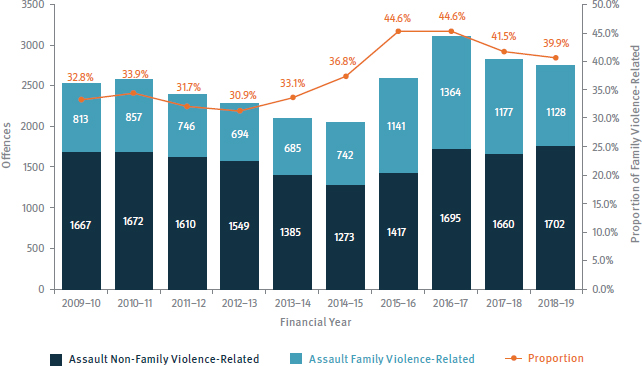
Source: PROMIS as at 2 July 2019
Case study
Strengthening ACT’s response to domestic and family violence in appropriate and culturally sensitive ways and supporting the efforts of the Coordinator-General for Family Safety. Family Violence Early Intervention Program ACT Policing recognises that family violence is not solely a law enforcement issue. It is a complex, pervasive issue that requires a whole-of-community approach. Policing is one component of this community response. In the last financial year ACT Policing has worked to improve early intervention strategies in an effort to disrupt the cycle of family violence. In addition to the 563 arrests for family violence offences in 2018-19, ACT Policing has continued to support ACT families to break the cycle of violence and has referred 6065 people to community support agencies. While ACT Policing remains dedicated to investigating every report of family violence and affords victims all possible protections, this alone will not break the cycle of violence — a holistic, pro-intervention approach is required. ACT Policing’s Family Violence Early Intervention Program (FVEIP) provides support to those who use, or who are at risk of using, violence in their family relationships and assists those involved in breaking the cycle of violence. The FVEIP officer engages with applicants and respondents in granted interim Family Violence Orders, as well as persons of interest in family violence incidents where no offence has been identified. Through the FVEIP, those who use, or who are at risk of using, violence in their family relationships can access appropriate support services, including mental health services, legal services, tenancy support and counselling services. During the reporting year, a female contacted the Family Violence Coordination Unit (FVCU) after police had attended her house in response to reports of her estranged son attempting to break in. The female and her son had a strained relationship due to her son’s escalating anti-social behaviour and aggression. The FVCU attended the address where they met the female and located her son. With the support of the FVEIP officer the son engaged with support agencies to acquire emergency accommodation, counselling, vocational training and ongoing support to address his aggression and anti-social behaviour. A week after police intervention, the son found housing and was continuing to engage with support organisations such as ‘EveryMan’* and ‘OneLink’**. The FVEIP supports ACT Policing’s pro-intervention approach to breaking the cycle of family violence and keeping our community safe. * ‘EveryMan’ is a peer support program providing support for men who are possible perpetrators of family violence with the aim of changing their behaviour towards their family members. ** ’OneLink’ is a service that provides information and connections for support services in the ACT.
|
Strengthening ACT’s response to family violence in culturally sensitive ways and supporting the efforts of the Coordinator-General for Family Safety remain key strategic special areas of focus for ACT Policing and the ACT Government.
ACT Policing’s FVCU and the Victims of Crime Team continue to work with government agencies and non-government organisations to ensure a collaborative approach in combating family violence and providing ongoing support to victims. ACT Policing’s Victims of Crime Team support people affected by family violence during investigative and prosecutorial processes and provide access to rehabilitation programs. This support is essential in assisting those involved to break the cycle of violence.
ACT Policing continues to strengthen its response to family violence through the use of the collaborative pro-intervention model focused on prevention and safety. This approach has seen a 78.3 per cent increase in the number of Personal Protection Orders served in 2018-19, with 1432 Personal Protection Orders issued, compared with 803 in 2017-18.
2018-19 saw the introduction of the FVEIP which provides support services, including mental health services, legal services, tenancy support and counselling services to those who use, or who are at risk of, using violence in their family relationships. This program supports ACT Policing’s commitment to early intervention in preventing family violence and other crime types.
ACT Policing’s FVCU is currently working to develop and deliver age-specific family violence awareness sessions to school children and community groups around Canberra. These sessions will contribute to ACT Policing’s efforts to improve childhood protective behaviours that are currently delivered by the Constable Kenny Koala program.
This performance measure also considers other assaults occurring in public places. There has been a 1.1 per cent decrease during 2018-19 (1577 offences reported in 2018-19, down from 1595 offences reported in 2017-18).
Anti-social behaviour and alcohol-fuelled violence continue to be key contributors to assaults in public places. In line with the Ministerial Direction, ACT Policing continues efforts in preventing and disrupting alcohol-fuelled violence and anti-social behaviour. ACT Policing is achieving this through ongoing engagement with partners to improve awareness of risks associated with alcohol abuse, the targeting of non-compliance with ACT’s liquor licensing laws and by conducting regular high-visibility patrols in licensed venues and across entertainment districts.
Case study
Working proactively and innovatively with Government to reduce and prevent alcohol-fuelled violence including enforcing liquor laws, maintaining a presence in night entertainment precincts and responding to alcohol-related violent incidents. Alcohol-fuelled violence is a wide-reaching and complex problem which affects all areas of our community. Alcohol, like all intoxicants, is over-represented as a factor in incidents of trauma and is a contributing factor in assaults, road trauma and social harm. Like all forms of substance abuse, a law enforcement response is only one part of the broader whole-of-community response required to minimise harm. ACT Policing works closely with government, liquor licensing authorities, business owners and the community, to improve awareness of the risks associated with alcohol abuse, enforce liquor licensing regulations and reduce instances of alcohol-fuelled violence. In the reporting year, ACT Policing continued efforts to disrupt instances of alcohol-fuelled violence through the utilisation of the ACT Watch House and the Sobering Up Shelter to remove those affected by alcohol and who posed a danger to themselves or others, from our streets. ACT Policing has a close collaborative relationship with the Sobering Up Shelter, operated by CatholicCare, which provides overnight support for people recovering from alcohol and/or other drug intoxication. The Sobering Up Shelter is an important diversionary alternative to traditional custodial facilities. The shelter is staffed by highly-trained workers who provide close observation and support to intoxicated people throughout the night. The shelter can also assist with referrals to other services including detox and withdrawal programs, drug and alcohol rehabilitation programs and counselling, mental health services and supported accommodation. Lodgement in protective custody at the ACT Watch House is utilised when there are no other reasonable avenues of care and protection available for an intoxicated person. Protective custody lodgements provide ACT Policing with an important method of ensuring those adversely affected by intoxication are cared for and removed from volatile, alcohol-fuelled and often dangerous situations. In 2018-19, ACT Policing placed 874 persons into protective custody for intoxication in the ACT Watch House, reducing anti-social behaviour in Canberra’s public spaces. While disruption is an important aspect of ACT Policing’s work to reduce alcohol-fuelled violence, enforcement of criminal and regulatory laws plays an equally important role. In 2018-19, ACT Policing continued to work with Access Canberra to reduce and prevent alcohol-fuelled violence through targeting non-compliance with the ACT’s liquor licensing laws. Joint compliance inspections at high-density community events have improved compliance with liquor licensing laws and have contributed to an improvement in the alcohol use culture at these popular events. These events include the National Multicultural Festival, ANZAC Day celebrations, the Black Opal Stakes and the Beer and Cider Festival.
|
Despite the overall decrease in assault offences there has been an increase in sexual offences compared to 2017-18. This increase could reflect a cultural shift in a willingness to report or could be attributed to historic cases being reported.
Additionally, there was a 25.2 per cent increase in ‘other offences against the person’ compared to the previous financial year (see Table 4.1). It is important to note that ‘other offences against the person’ only account for a small percentage of the total number of person offences. This change is due to an increase in reported threatening behaviour which is associated to family violence-related incidents.
The criminal conduct associated with serious and organised crime continues to be a key priority for ACT Policing. Taskforce Nemesis, established in 2014, focuses on targeting, disrupting and apprehending members of criminal motorcycle gangs involved in criminal activity. Through Taskforce Nemesis, ACT Policing continues to proactively disrupt criminal gang members to deter and detect criminal activity. The confiscation of criminal assets continues to be an effective tool in the prevention and disruption of serious and organised crime including against criminal gangs. It prevents the reinvestment of illegally-obtained wealth into criminal activity and forms an important part of a holistic, whole-of-community response to organised crime.
In 2018-19, the ACT Government committed $1.59 million over four years to bolster the capability of Taskforce Nemesis. This provided funding for two forensic accountants, one surveillance team member and associated equipment and training. These funded positions enhanced ACT Policing’s capability to respond to serious and organised criminal activity in the ACT, strip criminal wealth and improved surveillance capability to monitor the activity of criminal gangs.
Serious and organised crime is not limited to openly-identifiable criminal gangs and ACT Policing continue to proactively target, prosecute and disrupt those involved in serious and organised crime in the ACT, regardless of their individual affiliations. ACT Policing deploys resources flexibly to ensure an appropriate police response to target and disrupt those seeking to cause harm in our community.
Case study
ACT Policing remains committed to combating criminal gangs. Through a multi-faceted and collaborative approach, ACT Policing works to detect and disrupt the operations of criminal gangs, apprehend those responsible for criminal activities, target their illicit proceeds and uphold community safety. Through the Financial Investigations Team and Taskforce Nemesis, ACT Policing continues to target criminal gangs, take the profit out of crime and keep our community safe. Taskforce Nemesis As our world becomes more complex and interconnected so to do criminal gangs and the environment in which they operate. Targeting criminal gangs requires a holistic policing response. In October 2018, Taskforce Nemesis received intelligence from the NSW Police Force in relation to the activities of a member of a criminal gang operating in the ACT. Initial investigations undertaken by Taskforce Nemesis resulted in the identification and location of the criminal gang member. After further investigation and engagement with associates and witnesses, investigators established that the criminal gang member had been inflicting a long-term pattern of harassment and threats via carriage service, in person and through an associate. Additional investigations revealed a pattern of family violence offences and threats, including: threat to shoot an animal, vehicle arson, demands for money, blackmail, stalking and threats to commit grievous bodily harm. Police executed a search warrant at the residence of the person of interest, revealing the premises was also being used as the criminal gang’s chapter club house. After an extensive search of the property police located and seized illicit drugs, cutting agents, mobile phones and various types of ammunition. The man was charged with:
In May 2019, the man was sentenced in the Supreme Court to more than four years imprisonment. While criminal gangs continue to pose a challenge to our community, operational successes such as this remove key players from their ranks and improve the safety of our community. ACT Policing remains committed to the targeted detection and disruption of criminal gangs and the apprehension of those who elect to support their activities.
|
Case study
Agile capabilities enable police to respond to increasingly complex and emerging crime, including serious and organised crime. ACT Policing is committed to taking the profit out of serious and organised crime. Through the detection, disruption and deterrence of criminal activity ACT Policing has had great operational successes against serious and organised crime in 2018-19. Operation Ghar ACT Policing has continued collaborative efforts to target and disrupt the supply of illicit drugs in our community. Operation Ghar was an ongoing targeted investigation into disrupting the supply and trafficking of illicit drugs in Canberra’s entertainment districts. Between May and July 2018, a targeted police operation was undertaken within the Canberra entertainment district involving overt and covert resources from ACT Policing, NSW Police Force and the broader AFP. On 1 August 2018, ACT Policing executed a number of search warrants at premises across Canberra identifying and seizing trafficable quantities of cocaine, in excess of 1000 MDMA pills—worth an estimated street value of $28,500—and $5000 cash. The subsequent arrest of four people, charged with a combined total of 21 offences of trafficking in controlled drugs has had a considerable impact on the trade of illicit drugs in Canberra’s entertainment precincts. ACT Policing continues to work with partner law enforcement agencies to curb the trade of illicit substances in the ACT.
|
Figure 4.3 illustrates the percentage of people in the ACT somewhat concerned or very concerned about becoming a victim of certain crime types compared to the national average.
FIGURE 4.3: PERCEPTION OF CRIME BY OFFENCE TYPE 2018-19 (IoE A)
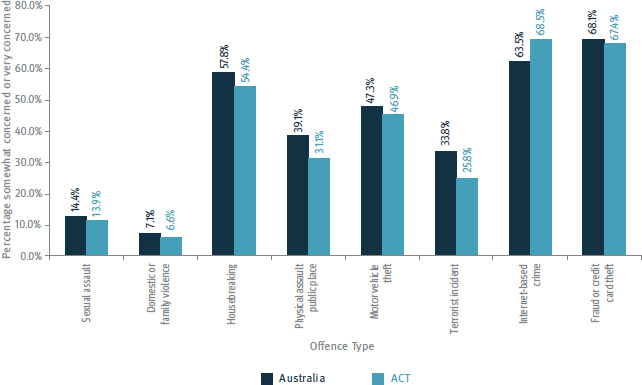
Source: National Survey of Community Satisfaction with Police, 2 July 2019
The results shown in Figure 4.3 demonstrate that the ACT has a lower percentage of people who are concerned of being victims of sexual assault, family violence and being physically assaulted in public places, compared to the national average.
Results from the NSCSP for 2018-19 (see Figure 4.3) indicate promising results, with the ACT demonstrating a lower percentage of people, 54.4 per cent, who are concerned about becoming a victim of housebreaking in the next 12 months when compared to the national average of 57.8 per cent.
FIGURE 4.4: FEELINGS OF SAFETY BY LOCATION AND TIME OF DAY 2018-19 (IoE E&F)
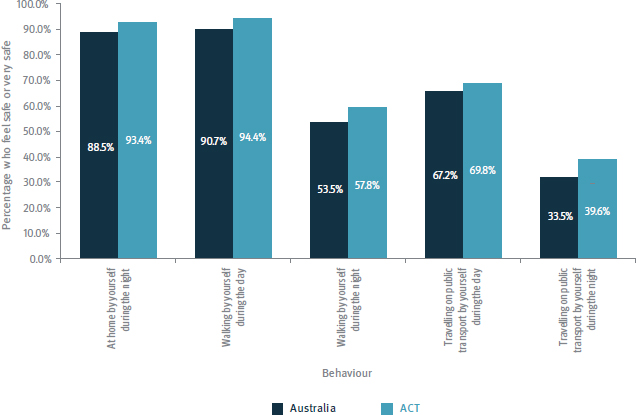
Source: National Survey of Community Satisfaction with Police, 2 July 2019
Figure 4.4 illustrates the percentage of people who feel safe by location and time of day.
The ACT demonstrates positive results in Figure 4.4, with higher percentages of people who feel safe walking around during night and day and travelling on public transport compared to the national average.
Performance Measure 2 — Number of offences against property reported or becoming known per 100,000 population.
Offences against property include, but are not limited to, robbery, burglary, motor vehicle thefts, property damage and other offences against property (including fraud, traffic, drug and weapon offences and other offences not elsewhere classified).
The target for this measure was 8300 or less offences against property reported or becoming known per 100,000 population. ACT Policing achieved the target for this measure with a result of 4663.9 offences per 100,000 population.
FIGURE 4.5: OFFENCES REPORTED AGAINST PROPERTY 2009-10 TO 2018-19
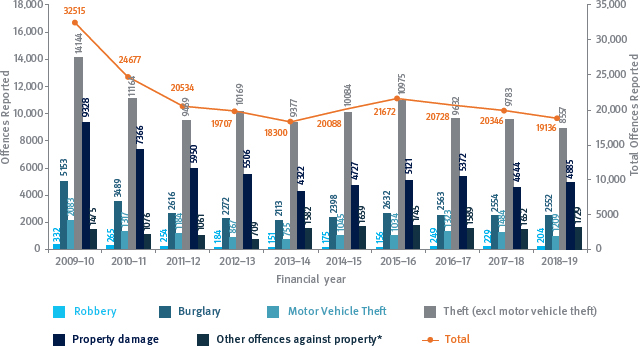
Source: PROMIS as at 2 July 2019
*Other offences against property includes fraud, blackmail, extortion, handling of stolen goods and environmental offences.
During 2018-19, there were a total of 19,136 offences against property reported to ACT Policing. This represents a decrease of 5.9 per cent (or 1210 offences) when compared to 2017-18.
TABLE 4.2: OFFENCES AGAINST PROPERTY BY OFFENCE TYPE — FINANCIAL YEAR COMPARISON
Offence type | 2017-18 | 2018-19 | Change (%) |
|---|---|---|---|
Robbery | 229 | 204 | -10.9% |
Armed robbery | 123 | 100 | -18.7% |
Unarmed robbery | 106 | 104 | -1.9% |
Burglary | 2554 | 2552 | -0.1% |
Burglary dwellings | 1678 | 1612 | -3.9% |
Burglary shops | 287 | 405 | 41.1% |
Burglary other | 589 | 535 | -9.2% |
Motor Vehicle Theft | 1484 | 1209 | -18.5% |
Theft (excl motor vehicle theft) | 9783 | 8557 | -12.5% |
Property damage | 4644 | 4885 | -5.2% |
Other offences against property* | 1652 | 1729 | 4.7% |
Total | 20,346 | 19,136 | -5.9% |
Source: PROMIS as at 2 July 2019
*Other offences against property includes fraud, blackmail, extortion, handling of stolen goods and environmental offences.
ACT Policing’s success in this performance measure is attributable to the effective strategies in place to reduce property crime offences. ACT Policing’s Crime Disruption Team continues to be a flexible resource, which is deployed where needed to address key priorities for the Canberra community. In 2018-19, this team led ACT Policing’s response to the spike in property damage offences, including vehicle thefts and vehicle arsons, through the targeting of recidivist offenders. As a result, motor vehicle theft offences decreased by 18.5 per cent (275 offences).
FIGURE 4.6: MOTOR VEHICLE THEFT OFFENCES REPORTED 2009-10 TO 2018-19
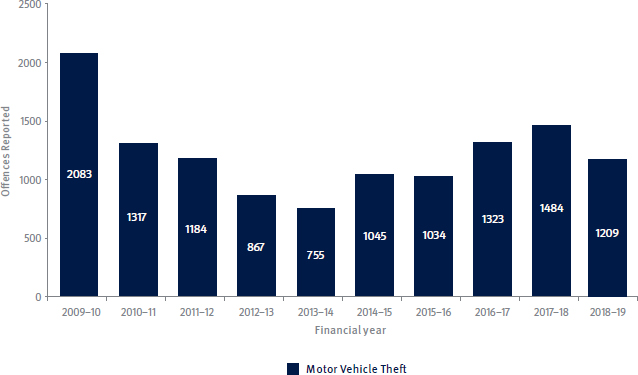
Source: PROMIS as at 2 July 2019
Motor vehicle theft offences have decreased in 2018-19 (see Figure 4.6). Through the arrests of a number of recidivist offenders there has been a substantial reduction in reported vehicle arsons.
FIGURE 4.7: RESIDENTIAL BURGLARY OFFENCES 2009-10 TO 2018-19
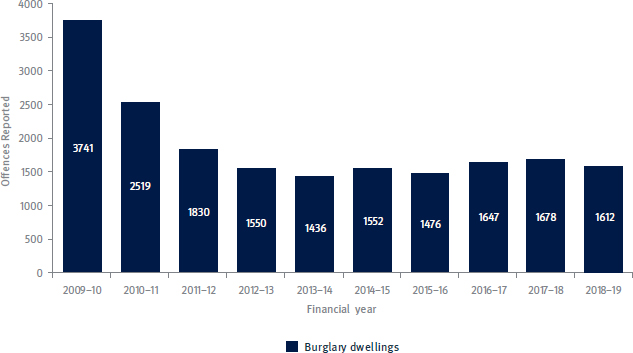
Source: PROMIS as at 2 July 2019
The positive results from the NSCSP and ACT Policing’s success in this performance measure can be attributed to ACT Policing’s work with the community to deter property crime through prevention and education initiatives. ACT Policing continues to be involved with a range of community groups, such as Neighbourhood Watch, to address complex social issues, prevent crime and reduce harm in the community. In September 2018, ACT Policing launched Secure September, in conjunction with ACT Neighbourhood Watch, to reinforce a whole-of-community approach to responsibility for crime prevention. The initiative included demonstrations to show the Canberra community how to increase the safety and security of their property by adopting simple safety measures around their homes.
In March 2019, ACT Policing also launched the Aggravated Robbery Prevention Booklet, which provided businesses with strategies to minimise the incidence and impact of an aggravated robbery. The booklet is designed to outline the correct security strategies that should be implemented to reduce the risk of businesses being targeted by criminals, focusing on prevention, building security, cash handling and staff training.
Criminal Investigations and Prosecutions
Performance Measure 3 — Percentage of offences against the person cleared.
Offences cleared relates to offences where there was an outcome during 2018-19. These outcomes include the identification of an offender (through an arrest or some other form of proceeding such as a summons or a caution), withdrawal of the complaint, or the determination that the offence was unsubstantiated. It is important to note the clearance of the offence may not necessarily occur in the same period in which it was reported.
The target for this measure required a clearance rate of 72 per cent or more for all offences against the person. ACT Policing did not meet the target for this measure, recording a clearance rate of 71.8 per cent.
FIGURE 4.8: OFFENCES REPORTED AGAINST THE PERSON CLEARED 2009-10 TO 2018-19
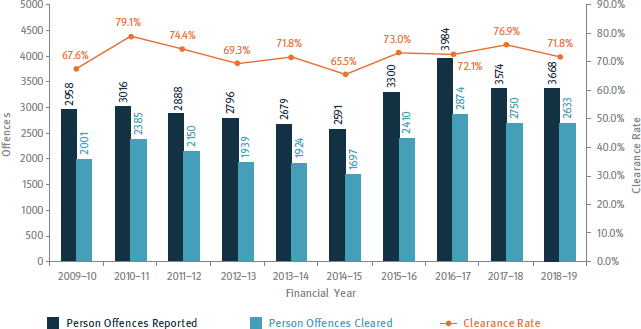
Source: PROMIS as at 2 July 2019
Performance Measure 4 — Percentage of offences against property cleared.
Offences against property cleared relates to offences where there was an outcome during 2018-19. These outcomes include the identification of an offender (through an arrest or some other form of proceeding such as a summons or a caution), withdrawal of the complaint, or the determination that the offence was unsubstantiated. These offences include robbery, burglary, motor vehicle theft, other theft, property damage and other offences against property. It is important to note the clearance of the offence may not necessarily occur in the same period in which it was reported.
The target for this performance measure was 15 per cent or more offences against property cleared. In 2018-19, ACT Policing did not meet the target for this measure, achieving a clearance rate of 13.9 per cent of total property offences.
The fleeting and opportunistic nature of many property offences is a factor that can contribute to the difficulty in clearing offences of this nature. Property offences frequently occur without the victim being present, creating additional challenges involved in identifying an offender and avenues of enquiry, which can affect the rates of clearance. The heavy reliance on technical investigations, including forensic testing, also contributes to delays in the clearance of offences of this type with conclusive scientific results often taking an extended period of time. The combination of these factors can result in investigations remaining uncleared for lengthy periods of time.
FIGURE 4.9: OFFENCES REPORTED AGAINST PROPERTY CLEARED 2009-10 TO 2018-19
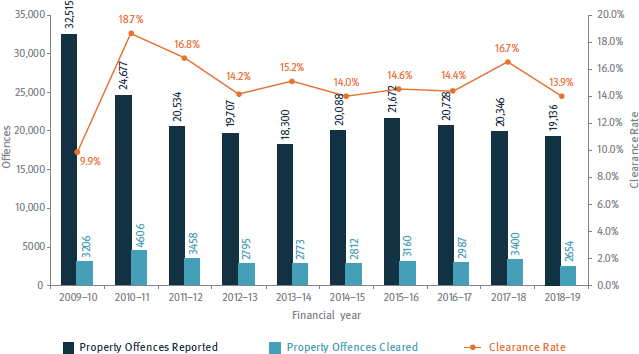
Source: PROMIS as at 2 July 2019
Performance Measure 5 — Percentage of briefs delivered to the Director of Public Prosecutions (DPP) within the designated timeframe.
The target for this measure is to deliver 75 per cent or more briefs to the DPP within the designated timeframe. The designated timeframe commences from the date of the plea by a defendant to the date disclosed by the DPP.
The timeframes are dependent on the particular matter and are subject to change by the DPP and are classified as follows:
- Adult matters: 42 days
- Family violence matters: 23 days
- Child matters: 30 days
ACT Policing met the target for this measure, achieving a positive result of 84.8 per cent of briefs delivered to the DPP within the designated timeframe.
This result is reflective of the collaborative work of ACT Policing, ACT DPP and the ACT Courts to improve efficiencies and reduce delays in the delivery of briefs of evidence. ACT Policing will continue to work with these partner agencies to create further efficiencies in time, cost and resources in the judicial system.
Performance Measure 6 — Percentage of cases finalised by offence proved in court.
The target for this measure was 82 per cent or more cases to be finalised by offence being proven in court. ACT Policing continues to perform well against this measure and achieved a result of 95.7 per cent.
In March 2019, ACT Policing commenced training in the use of Body Worn Cameras (BWC), which will support the number of cases proven in court. The BWC video footage will provide important and impartial evidence early in legal proceedings.
BWC video footage will also provide improved results for victims of crime through the provision of independent evidence to courts. This will assist in reconciling often differing evidence of witnesses.
Performance Measure 7 — Percentage of cases otherwise resolved.
This measure relates to matters where defendants are found unfit to plea due to mental illness. The target for this measure was to ensure 5 per cent or less of cases were otherwise resolved (other than by court, a not-guilty verdict, or otherwise withdrawn). ACT Policing achieved the target recording 1.3 per cent of cases otherwise resolved.
Incidents involving mental health consumers can be complex to manage, requiring a joint agency collaborative approach to ensure that positive outcomes are achieved. ACT Policing responds to this challenge through the Mental Health Community Policing Initiative, which is a partnership between the Mental Health Justice Health Alcohol and Drug Services portfolio, the ACT Ambulance Service, the Canberra Hospital, Calvary Hospital and ACT Policing. This coordinated approach ensures that the root cause of an incident is examined and addressed, reducing the likelihood of further instances of behaviour warranting police intervention.
Through the ongoing delivery of enhanced mental health training to members and the continued utilisation of the mental health clinicians embedded in the ACT Policing Operations centre, ACT Policing will continue to build knowledge and capability around best practice approaches to dealing with mental health consumers. ACT Policing will continue to strengthen partnerships with support services and the ACT Government, working together to achieve better outcomes for mental health consumers.
Outcome: Public Safety
Police Response
Performance Measure 8 — Response times for Priority One incidents within 10 minutes.
The target for Priority One (life threatening or critical) incidents was a response time of 10 minutes or less for 80 per cent or more of incidents. ACT Policing achieved this target by responding to 81 per cent of Priority One incidents within 10 minutes.
All calls to ACT Policing are answered by ACT Policing Operations, which provides a 24 hour, 7 day a week overwatch of incidents and policing responses.
Whole-of-community responses are required to disrupt the cycle of crime. In recognising this, ACT Policing Operations continue collaborative partnerships with agencies including ACT Fire and Rescue, ACT Ambulance Service and ACT Mental Health to ensure resources are deployed flexibly in addressing crime.
Data in Figure 4.10 shows results against this measure since 2013-14.
FIGURE 4.10: RESPONSE TIMES FOR PRIORITY ONE INCIDENTS 2013-14 TO 2018-19
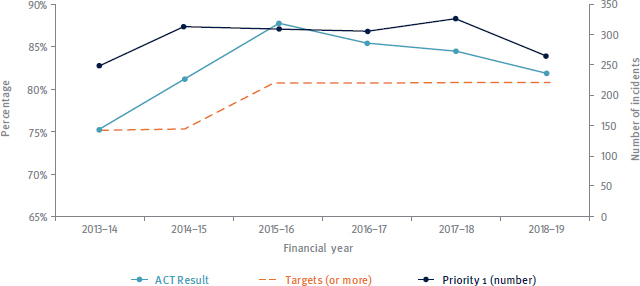
Source: PROMIS as at 2 July 2019
Performance Measure 9 — Response times for Priority Two incidents within 20 minutes.
The target for Priority Two is 80 per cent or more incidents responded to within 20 minutes. ACT Policing did not achieve the target recording a result of 74.5 per cent.
A 33.3 per cent increase in calls for Priority Two matters in the last five years continues to present a challenge for ACT Policing and has contributed to ACT Policing not achieving this target. The continued expansion of Canberra suburbs has also contributed to ACT Policing failing to meet this measure by 5.5 per cent, or 773 incidents.
ACT Policing’s failure to meet the Priority Two target continues to be symptomatic of increased calls for service, expanding geographical responsibility, and more resource-intensive matters such as family violence offences, alcohol-related assaults and mental health incidents which require police attendance.
A number of measures are underway to improve response times, as part of the ACT Policing’s transition to the new community-focused and crime prevention model of policing. As ACT Policing transition to the new model we will have the ability to better deploy our resources based on intelligence. By operationalising intelligence and redesigning how we police, ACT Policing will proactively address developing trends in a preventative manner resulting in fewer calls for assistance.
FIGURE 4.11: NUMBER OF PRIORITY TWO INCIDENTS 2013-14 TO 2018-19
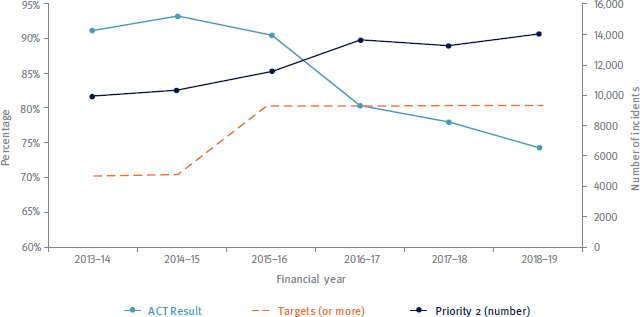
Source: PROMIS as at 2 July 2019
Performance Measure 10 — Response times for Priority Three incidents within 48 hours from initial contact.
The target for this measure was police responsding to 90 per cent of incidents or more within 48 hours from the initial contact by the complainant. ACT Policing achieved the target, recording a result of 97.5 per cent.
Performance Measure 11a — Percentage of Triple Zero calls answered on first or second presentation.
The target for this Performance Measure was 92 per cent or more of Triple Zero calls answered on the first presentation. ACT Policing did not meet the target for this Performance Measure, recording a result of 88.6 per cent.
This result can be attributed to statistical recording limitations experienced when the ACT Policing Operations centre underwent a major refurbishment in 2018-19. During the temporary relocation of the Operations telephone system to Tuggeranong Police Station, difficulties were experienced in differentiating statistics related to police Triple Zero calls and calls for police assistance on 131 444. While this technical difficulty resulted in challenges to the recording of statistics, no adverse effects were experienced to the answering of Triple Zero calls; ACT Policing continued to receive and respond to Triple Zero calls during the temporary relocation.
During this period, a number of ACT Policing Operations members were co-located with Emergency Service Agency (ESA) staff in the ESA call centre. This mechanism provided an important redundancy to ensure that Triple Zero calls continued to be answered and responded to appropriately. Following the completion of scheduled upgrades, ACT Policing Operations resumed operations at Winchester Police Centre. Statistical recording resumed as usual following the resumption of operations at Winchester Police Centre.
While ACT Policing continued to answer and respond to all Triple Zero calls during this period the absence of statistical data during upgrade works meant ACT Policing was unable to quantify the exact number of Triple Zero calls, if any, that may have been answered on a particular presentation. For this reason, the Performance Measure recording should be considered as indicative only.
Performance Measure 11b — Percentage of Triple Zero calls answered on second presentation.
The target for this Performance Measure was 98 per cent or more of Triple Zero calls answered on the second presentation. ACT Policing did not meet the target for this Performance Measure recording a result of 94.8 per cent. The failure to meet this target is explained at Performance Measure 11a.
Public Order and Emergency Management
Performance Measure 12 — Percentage of the community satisfied with police in dealing with public order problems.
The target for this measure is the national average or more as determined by the NSCSP. The national average for 2018-19 was 71.4 per cent. The ACT recorded a higher percentage of the community satisfied with police in dealing with public order problems than the national average, recording a result of 72.7 per cent.
Performance Measure 13 — Review and testing of arrangements for responding to and recovering from emergencies and disasters.
This Performance Measure has no corresponding numerical figures for ACT Policing to report against.
Keeping the ACT safe from emergencies and disasters remains a priority for ACT Policing. We maintain a focus on preventing, disrupting and responding to the evolving threat of violent extremism and terrorism, with a particular focus on crowded places. In 2018-19, ACT Policing continued to work with colleagues in the AFP, the Australian intelligence community, interstate policing agencies, the Australia and New Zealand Counter-Terrorism Committee and public and private sector agencies, to monitor and assess the security environment to ensure public spaces in the ACT remain safe.
ACT Policing’s Emergency Management and Planning team continue to support Australia’s Strategy for Protecting Crowded Places from Terrorism through engagement with partners, including the ACT Government and the delivery of Crowded Places Forums.
ACT Policing continued to deliver a robust community policing service to major events in 2018-19, including New Year’s Eve celebrations, Summernats’ City Cruise, Australia Day celebrations, the National Multicultural Festival, Enlighten, Skyfire and Floriade. Through continued engagement with the ACT Government, businesses, community groups and stakeholders, 2018-19 saw the safe and successful delivery of these major events and many more community events across the ACT.
Case study
Continue to focus on preventing, disrupting and responding to the evolving threat of violent extremism and terrorism with a particular focus on crowded places. Ensuring our community is best protected from the risks posed by terrorism and violent extremism requires forward-thinking and the involvement of the whole community. Public safety is everyone’s responsibility and ACT Policing is committed to continuing to work with the community, partner agencies and government to ensure that our community remains a safe one. In support of Australia’s Strategy for Protecting Crowded Places from Terrorism (the Strategy), 2018-19 has seen ACT Policing work with the ACT Government, partner agencies and the operators of crowded places to identify and mitigate potential risks. Through Crowded Places Forums and the proactive provision of advice to stakeholders, ACT Policing has continued to achieve the outcomes of the Strategy and mitigate the risks of terrorism and violent extremism. In 2018-19, ACT Policing facilitated two Crowded Places Forums and attended numerous national forums comprising of key stakeholders of Commonwealth, state and territory and local governments supporting the outcomes of the Strategy. Forums to date have focused on a range of themes including education and health, iconic locations, places of worship and the retail sector. Keeping our community safe from violent extremism and terrorism is a responsibility that ACT Policing takes very seriously and shares with government and law enforcement agencies around the country. ACT Policing continues to work closely with state, territory and Commonwealth stakeholders to ensure the timely sharing of information, the monitoring of threats as they emerge and that nationally-consistent and appropriate legislative frameworks are in place. Through continued work with Canberra businesses, law enforcement and intelligence partners, government and our community, ACT Policing is continuing to mitigate the risks of violent extremism and terrorism and keep our community safe.
|
Road Safety and Traffic Management
Performance Measure 14 — Number of road crashes resulting in death per 100,000 population
The target for this performance measure was 4.2 or less road crashes resulting in death per 100,000 population. ACT Policing achieved the target, recording a result of 1.5 fatal road crashes per 100,000 population during 2018-19.
As presented in Figure 4.12, the number of fatal collisions per 100,000 population in the ACT remains consistently below the national average.
FIGURE 4.12: ROAD CRASHES RESULTING IN DEATH PER 100,000 POPULATION 2014-15 TO 2018-19
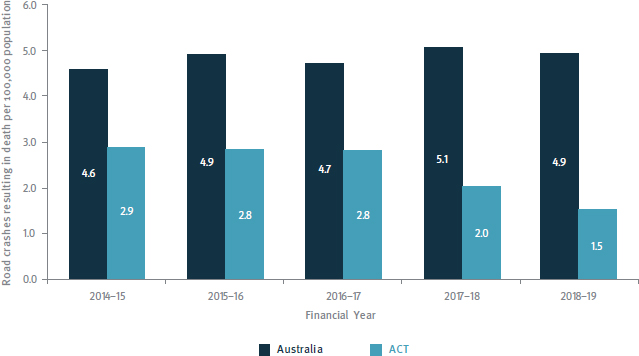
Source: Australian Road Deaths Database as at 30 June 2019
The reduction of road trauma remains a priority for ACT Policing. While 2018-19 saw a decrease in road fatalities compared to the past financial years, even one death on our roads is one too many. ACT Policing and the ACT Government strive for a zero road toll through the ACT Road Safety Strategy ‘Vision Zero’ campaign, which appeals to road users to slow down, be cautious, be safe and be responsible while driving on the roads.
ACT Policing Traffic Operations continue to work closely with the ACT Government, media outlets, the NSW Police Force and community organisations to realise ‘Vision Zero’ through a coordinated, whole-of-government approach to reducing road trauma.
Performance Measure 15 — Number of road crashes resulting in injury per 100,000 population.
The target for this measure was 180 or less road crashes resulting in injury per 100,000 population. ACT Policing achieved this measure with the number of road collisions resulting in injury recorded at 121.4 per 100,000 population. This result can be attributed to ACT Policing’s continued commitment to reducing road trauma through targeted traffic operations, community engagement and the removal of impaired drivers from our roads.
FIGURE 4.13: MOTOR VEHICLE COLLISIONS RESULTING IN INJURY 2014-15 TO 2018-19

Source: PROMIS as at 2 July 2019
ACT Policing recognises that drug and alcohol-impaired drivers are over-represented in vehicle collisions. Removing impaired drivers through roadside drug and alcohol tests, deterrence strategies and community education engagement strategies remains a cornerstone of ACT Policing’s commitment to reduce trauma.
ACT Policing recognises that continued improvement of our road-use culture requires a whole-of-community response. In 2018-19, the ACT Policing Traffic Operations portfolio continued to work with the ACT Government, partner agencies and community groups to deliver holistic, positive messaging to improve our road-use culture and reduce the incidence of road trauma in our community.
ACT Policing continues to work with the ACT Government to deliver the targeted road safety outcomes of the ACT Road Safety Calendar. In collaboration with the ACT Government, 2018-19’s summer months saw ACT Policing Traffic Operations target alcohol and drug-impaired drivers through targeted and random roadside testing, the delivery of social media engagement programs and the use of marked policing vehicles as a platform for road safety messaging.
Case study
Improving road safety through particular emphasis on vulnerable road users and combating anti-social and dangerous driving behaviours including speeding and driving while impaired or distracted. 2018-19 Kings Highway Road Safety Partnership The summer holiday period is a busy period on the roads especially with large numbers of motorists travelling to the coast on the Kings Highway. Increased numbers of road users, fatigue and alcohol consumption are all factors that contribute to road trauma. December 2018 saw the launch of the 2018-2019 Kings Highway Road Safety Partnership on the ACT/NSW border. The Kings Highway Road Safety Partnership formed a decade ago with members from Eurobodalla Shire, Shoalhaven City and Queanbeyan-Palerang Regional councils, ACT Policing, NSW Police Force, Roads and Maritime Services and the Justice and Community Safety Directorate. This partnership provides a coordinated approach between jurisdictions and the community, promoting education and coordinating traffic enforcement to reduce road trauma on one of the region’s busiest holiday routes. During this year’s campaign, ACT Policing and the NSW Police Force worked jointly to enforce traffic law on the Kings Highway. Members of ACT Policing Traffic Operations maintained a high visibility presence, targeting speeding and impaired drivers. Through overt deterrence, targeted alcohol and drug testing stations, road safety messaging and a social media strategy, road users were reminded to obey speed limits, take regular breaks and be patient and alert when driving in heavy traffic conditions. During this campaign, there were no serious trauma incidents or fatal accidents recorded. This significant outcome continues the road safety improvements delivered by the partnership, which has seen the Kings Highway road toll halve since the partnership commenced in 2008. ACT Policing recognises the importance of these partnerships in strengthening the efforts to improve road safety. ACT Policing will continue to work with stakeholders to provide collaborative approaches in reducing road trauma.
|
Outcome: Community and Partner Engagement
Community Support and Whole-of-Government Engagement
Performance Measure 16 — Percentage of the community satisfied in general with services provided by police.
The target for this measure is the national average or more as determined by the NSCSP. The national average for 2018-19 was 79.9 per cent, while the ACT result was 80.8 per cent.
Performance Measure 17 — Percentage of the community who have confidence in police.
The target for this measure is the national average or more as determined by the NSCSP. The national average for 2018-19 was 84.1 per cent, while the ACT result was 86.7 per cent.
As shown in Figure 4.14, ACT Policing continues to perform well against the performance measures relating to community satisfaction and confidence, with 2018-19 results for the ACT above the national average.
FIGURE 4.14: SATISFACTION AND CONFIDENCE IN POLICE 2018-19
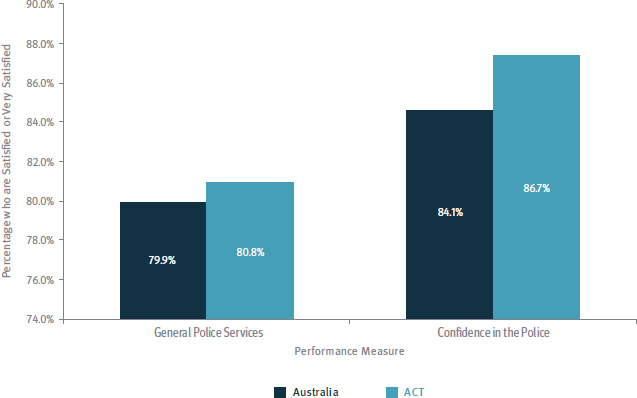
Source: National Survey of Community Satisfaction with Police, 2 July 2019
Education and public messaging are important components of crime prevention, community safety and enhancing confidence in police. ACT Policing are committed to raising awareness of community safety through active engagement with the entire community and the delivery of effective safety messaging.
ACT Policing’s Community Safety, Education and Diversion Team are at the forefront of community engagement, representing ACT Policing at a variety of events and venues and building relationships with the Canberra community. Continued community liaison and engagement assists in building awareness of how to remain safe in the community.
As ACT Policing transitions to a new, community-focused model of policing, reinvigorating community engagement programs will become increasingly important. Education, disruption, prevention, diversion, community engagement and problem-solving activities are central to a policing service for the future. Over time, the work done in this space will further enhance confidence in ACT Policing and provide a safer community for ACT residents.
Figure 4.15 shows a comparison of results between the ACT and the national average relating to community perceptions of police. The questions focused on the perceived professionalism, fairness and honesty of ACT Policing members.
FIGURE 4.15: PUBLIC PERCEPTION OF POLICE 2018-19
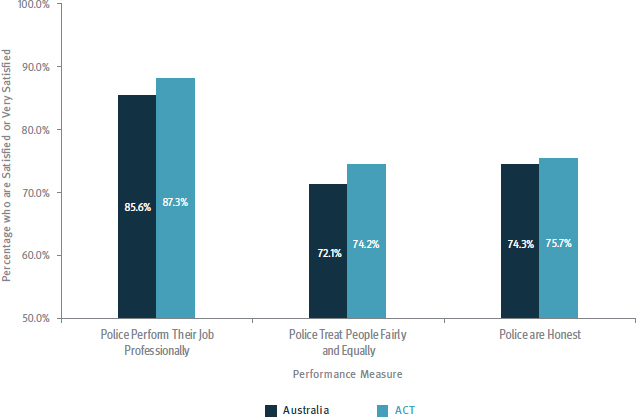
Source: National Survey of Community Satisfaction with Police, 2 July 2019
The ACT’s results in Figure 4.15 are positive with a higher percentage of people believing that police perform their job professionally, are honest and treat people fairly and equally, compared to the national average.
Performance Measure 18 — Percentage of eligible young people referred to restorative justice.
The target for this Performance Measure is for ACT Policing to refer 100 per cent of eligible young offenders to restorative justice.
Results for 2018-19 show ACT Policing did not meet the target for this Performance Measure, with 94 per cent of eligible young offenders referred to restorative justice. ACT Policing failed to meet this target by 6 per cent, which equated to seven individuals.
ACT Policing is committed to meeting the target for the Performance Measure and is working with government and non-government partners to identify options for increased diversion and community-based referrals.
Early intervention, engagement and diversion are central to disrupting the life cycle of criminal offending and ACT Policing will continue efforts to engage with and divert youth away from harmful behaviours. ACT Policing members regularly attend ACT schools, educational and sporting facilities to engage with youth, teachers and families to deliver prevention initiatives, provide advice and foster positive relationships that engender trust, respectful attitudes and acceptable social behaviours. Through the Constable Kenny Koala program, ACT Policing engaged directly with over 25,500 students in 1152 classrooms, introducing personal safety concepts, informing appropriate and socially acceptable behaviours and ensuring children feel comfortable to approach people to seek help when required.
In 2018-19, ACT Policing has demonstrated ongoing support to the Canberra Police and Community Youth Club and their early intervention programs that combine educational programs and skills-based pathways to reduce the risk of reoffending in at-risk young people. ACT Policing will continue to support youth engagement and early intervention strategies to divert vulnerable groups from the criminal justice system.
Case study
Continuing the commitment to early intervention and diversion strategies including restorative justice, with a focus on vulnerable groups, in particular young people and Aboriginal and Torres Strait Islander peoples. ACT Policing and the Canberra Police and Community Youth Club ACT Policing continues to focus on early intervention, including diversionary, educational and restorative justice programs, to deter vulnerable groups from the criminal justice system through the ongoing support of the Canberra Police and Community Youth Club (PCYC). ACT Policing has continued to support the delivery of early intervention programs run by PCYC including the Intensive Diversion Program and the Project Booyah program. In February 2019, an ACT Policing officer joined the PCYC team of youth workers, counsellors and health professionals to deliver the Project Booyah program. These programs are designed to improve life outcomes for young people from disadvantaged backgrounds who are disengaged from mainstream education and are at risk of entering, or have been involved with, the justice system. ACT Policing members are encouraged to consider PCYC referrals for young people at risk to assist in the prevention and reduction of crime committed by young people in the ACT. Throughout these 20 week early intervention programs, participants:
ACT Policing is proud to support participants through these programs. Graduates of these programs have succeeded in returning to full-time education, obtaining vocational education or securing meaningful employment. These outcomes are a credit to PCYC’s programs and help to improve life outcomes for participants and distance participants from the criminal justice system.
|
ACT Policing continued to prioritise efforts for vulnerable community members other than youth, including the Aboriginal and Torres Strait Islander community. ACT Policing is committed to achieving the outcomes of the ACT Aboriginal and Torres Strait Islander Agreement 2019-2028 and works with the local Aboriginal and Torres Strait Islander community to implement policies and best practice that support these outcomes.
During the reporting year, ACT Policing has worked collaboratively with partner agencies and government directorates with the aim of reducing the over-representation of Aboriginal and Torres Strait Islander peoples in the justice system through early intervention and diversion strategies. In early 2019 legislative changes to the cautioning framework commenced lowering the threshold for granting a caution from ‘full and frank’ admissions to ‘does not deny responsibility’ for the commission of an offence. This change is anticipated to increase the number of people diverted away from the criminal justice system, especially for young people and Aboriginal and Torres Strait Islander peoples.
ACT Policing remains committed to ongoing engagement with partner agencies, government directorates and the wider community to improve life outcomes for Aboriginal and Torres Strait Islander peoples in the ACT.
Case study
Continuing the commitment to early intervention and diversion strategies including restorative justice with a focus on vulnerable groups, in particular young people and Aboriginal and Torres Strait Islander peoples. Chief Police Officer’s Advisory Board ACT Policing recognises that ongoing connection with Aboriginal and Torres Strait Islander communities is imperative in improving outcomes for Aboriginal and Torres Strait Islander peoples.
In late 2018, the Chief Police Officer’s Aboriginal and Torres Strait Islander Advisory Board was established. The Advisory Board meets regularly to provide advice to the Chief Police Officer and oversight of ongoing initiatives. This Advisory Board aims to strengthen a relationship between police and the Aboriginal and Torres Strait Islander community which is based on mutual respect and trust. The Advisory Board considers strategic issues regarding ACT Policing’s engagement with Aboriginal and Torres Strait Islander peoples in the ACT. The Board also provides expert advice and perspectives on ACT Policing strategic initiatives to improve outcomes for Aboriginal and Torres Strait Islander peoples in the ACT. The establishment of the Advisory Board complements ongoing community forums held by the Chief Police Officer and assists ACT Policing to form and strengthen relationships with individuals, groups and community stakeholders. As a result of the effective and honest engagement with the Advisory Board, 2018-19 saw the installation of two new flag poles at Winchester Police Centre. Flying the Aboriginal and Torres Strait Islander flags alongside the Australian, ACT and AFP flags is a small but meaningful step in the strengthening of relationships with, and outcomes for, our Aboriginal and Torres Strait Islander communities. ACT Policing looks forward to continued engagement with the Advisory Board and with the wider community to improve relationships with the Aboriginal and Torres Strait Islander community. In October 2018, ACT Policing launched two new purpose-built police vessels. In recognition of the ongoing partnership between ACT Policing and the Aboriginal and Torres Strait Islander community, the vessels were named ‘Yhuuramulun’ and ‘Ngunnawal’ to symbolise the people and pathways of the community. The larger of the two vessels was named Yhuuramulun which means ‘dreaming’. The name was chosen, in consultation with the Ngunnawal elders, because the boat will travel along the same river systems the Ngunnawal people have used for more than 65 thousand years. Known as the ‘dreaming paths’ the boat’s connection with the water is symbolic of the spiritual connection Indigenous people have to the river system. Yhuuramulun is a custom built, rigid hull inflatable boat that can be transported by road to other ACT waterways. The second vessel Ngunnawal was named after the Canberra region’s traditional owners. Ngunnawal represents the spiritual ancestors who camped along the waterways. This shows our respect for the strong spiritual connection of the Ngunnawal people to this region. Ngunnawal is a general purpose boat. It is faster than its predecessor, allowing for improved response times during water rescue operations or emergency evacuation. The boat is also designed for search and rescue and has the ability to tow vessels in distress. The tradition of naming a boat dates back thousands of years. The ceremony was thought to keep the vessel and crew safe, while the name itself was symbolic of spiritual beliefs. The new police vessels are a visible sign of ACT Policing’s commitment in acknowledging and respecting Aboriginal and Torres Strait Islander peoples in the ACT.
|
Performance Measure 19 — Number of persons referred to community support agencies.
The annual target for this measure is 5500 or more persons referred to community support agencies. Results for 2018-19 show ACT Policing exceeded this target with 6065 referrals which is 10.3 per cent above the target.
Referral arrangement changes implemented by partner agencies in 2018 meant that family violence referrals to the Domestic Violence Crisis Service (DVCS) are no longer submitted through SupportLink. However, they still count towards the total number of community support agency referrals. During 2018-19, ACT Policing referred 1490 incidents of family violence to DVCS and 723 victims accepted DVCS support.
ACT Policing recognises the valuable assistance provided by community support agencies to those in crisis. ACT Policing works closely with SupportLink to ensure our policing members are aware of the various support services available and the assistance that SupportLink can provide. In 2018-19, SupportLink delivered continuing information sessions to ACT Policing’s Operations Committee and regional training days. Through this continued engagement and up-skilling, ACT Policing are working to ensure that those requiring support or assistance can be afforded all possible help.
To enhance the referral system, ACT Policing has introduced a SupportLink mobile solution application. Initially trialled by ACT Policing Belconnen patrol members in December 2018 and later rolled out more broadly to all ACT Policing members, this application allows police to make SupportLink referrals in the field. This initiative is anticipated to increase the number and speed of referrals made to community support agencies.
ACT Policing’s Criminal Investigations continue to refer all victims of sexual assault to the Wrap-Around Committee which coordinates the support of various community services. ACT Policing also has a long-standing and constructive working relationship with the Canberra Rape Crisis Centre. This is evidenced by the recent re-signing of the joint Memorandum of Understanding. ACT Policing will continue to identify further avenues to increase the number of referrals to community support services.
Performance Measure 20 — Number of referrals to drug diversion programs (drug demand reduction effort).
The annual target for this measure was 80 or more referrals to drug diversion programs.
Results for 2018-19 show ACT Policing exceeded this target with 167 people diverted into the Early Intervention and Drug Diversion Program. Over the years ACT Policing has consistently exceeded this target. We will continue to focus on alternative avenues to formal court processes to reduce the pressure on the justice system and minimise the harm caused by illicit substances.
Performance Measure 21 — ACT Policing Victim Liaison Officers providing contact with victims of indictable crime reported to police.
The target for this measure was 80 per cent or more. ACT Policing achieved this target with 87.2 per cent of victims contacted by Victim Liaison Officers (VLOs) during 2018-19.
ACT Policing recognises that the assistance provided to victims of crime through the VLOs is key to reducing further victimisation, disrupting the escalation of crime and providing victims with appropriate support. In concert with community support agencies and Family Violence Order Liaison Officers, ACT Policing’s VLOs continue to ensure that victims are assisted and provided with appropriate and timely support.
5 Professional standards
AFP Professional Standards Framework
ACT Policing Complaint Statistics

Artist: Anthony Bean The connection of the circles represents collaboration and the coming together of ideas.
The term professional standards relates to the Commissioner’s expectation that all AFP appointees will serve with integrity. This includes those in ACT Policing.
AFP Professional Standards, which sits within the AFP’s Workforce Development and Culture function, is responsible for developing and maintaining the highest professional standards throughout the organisation, as well as overseeing and investigating complaints about the conduct of AFP appointees.
The AFP’s professional standards are underpinned by the AFP Core Values (see Chapter 3: Our Values) and the AFP Code of Conduct. Further information on the AFP Values and the AFP Code of Conduct is available on the AFP website (afp.gov.au).
AFP Professional Standards Framework
The AFP’s Professional Standards Framework is governed by Part V of the Australian Federal Police Act 1979 (Cth) and the Australian Federal Police Regulations 1979 (Cth).
This framework is further supported by internal governance such as the Commissioner’s Order on Professional Standards and the National Guideline on Complaint Management. The Commonwealth Ombudsman and the Australian Commission for Law Enforcement Integrity (ACLEI) oversee the framework.
The AFP is committed to managing fraud and corruption risks as part of its everyday business and complies with the Australian National Audit Office Better Practice Guide on Fraud Control in Australian Government Entities. As a Commonwealth entity, the AFP has a Fraud Control and Anti-corruption Plan which ensures compliance with the Public Governance, Performance and Accountability Rule 2014 (Cth).
Relevant ACT Government Ministers can be informed about ACLEI’s activities when investigating serious corruption and systemic corruption as defined by the Law Enforcement Integrity Commissioner Act 2006 (Cth).
The AFP’s Professional Standards Framework adopts a tiered approach according to the seriousness of the breach:
- Category 1 conduct — relates to customer service matters
- Category 2 conduct — relates to minor misconduct
- Category 3 conduct — relates to serious misconduct including breaches of the criminal law or serious neglect of duty
- Corruption issues (also referred to as Category 4).
Complaints dealing with Categories 1 and 2 of the AFP’s Professional Standards Framework are managed by line-managers through the ACT Policing Complaint Management Team.
More serious matters that may result in employment suitability considerations (Category 3) are investigated by AFP’s Professional Standards. Every Category 3 matter is also reported to the Commonwealth Ombudsman for additional oversight.
Complaints and information about corrupt conduct of AFP appointees are immediately referred to ACLEI. Pursuant to section 26 of the Law Enforcement Integrity Commissioner Act 2006 (Cth), the Integrity Commissioner will determine whether a matter is investigated jointly with AFP Professional Standards, solely by ACLEI or as an AFP-only investigation.
ACT Policing Complaint Statistics
Financial year 2018-19
During the financial year 2018-19, AFP’s Professional Standards received 122 complaints relating to ACT Policing resulting in 216 alleged conduct breaches1 being recorded.
TABLE 5.1: ALLEGED CONDUCT BREACHES RECORDED DURING LAST FOUR YEARS BY CATEGORY2
ALL ACT POLICING BREACHES | 2015-16 | 2016-17 | 2017-18 | 2018-19 |
|---|---|---|---|---|
Category 1 | 100 | 67 | 66 | 82 |
Category 2 | 131 | 120 | 143 | 69 |
Category 3 | 55 | 55 | 48 | 49 |
Corruption issues | 10 | 9 | 19 | 16 |
Total | 296 | 251 | 276 | 216 |
TABLE 5.2: ALLEGED CONDUCT BREACHES RECORDED DURING 2018-19 BY SOURCE
SOURCE | TOTAL BREACHES | PERCENTAGE |
|---|---|---|
Anonymous member of the public | 5 | 2.31% |
Member of the public | 136 | 62.96% |
Reporting another AFP member | 63 | 29.17% |
Self-reported | 12 | 5.56% |
Total | 216 | 100% |
TABLE 5.3: FINALISED CONDUCT BREACHES DURING 2018-19 BY CATEGORY3
ALL ACT POLICING BREACHES | ESTABLISHED | NOT ESTABLISHED | DISCRETION NOT TO PROCEED |
|---|---|---|---|
Category 1 | 4 | 56 | 7 |
Category 2 | 20 | 52 | 23 |
Category 3 | 19 | 33 | 6 |
Corruption issues | 0 | 10 | 8 |
Total | 43 | 151 | 44 |
TABLE 5.4: ESTABLISHED CONDUCT BREACHES DURING 2018-19
CONDUCT BREACH | NUMBER ESTABISHED |
|---|---|
Information access | 8 |
Inadequate investigation | 5 |
Fail to comply with procedure | 4 |
Inadequate service | 4 |
Inappropriate behaviour/conduct — serious | 3 |
Unauthorised discharge of conducted electrical weapon | 3 |
Inappropriate behaviour/conduct | 3 |
Misuse of credit card | 2 |
Misuse of authority | 2 |
Conflict of interest | 2 |
Violence — family and domestic | 2 |
Assault | 1 |
Fail to record and report | 1 |
Due care/diligence failure | 1 |
Fail to declare association | 1 |
Breach of Commissioner’s Order 3 — non-serious nature | 1 |
Total | 43 |
TABLE 5.5: COMPLAINTS ON HAND4 AS OF 1 JULY 2019
Timeliness benchmarks are applied to each category with a target of 90 per cent to be finalised within the specified number of days. The benchmarks are:
- 42 days for Category 1 matters
- 66 days for Category 2 matters
- 256 days for Category 3 matters.
Corruption issues fall under the Law Enforcement Integrity Commissioner Act 2006 (Cth) and are not subject to a timeliness benchmark.
ALL ONGOING ACT POLICING COMPLAINTS | COMPLAINTS ONGOING | NUMBER OF COMPLAINTS OVERDUE | EXCEEDS 7 DAYS OVER BENCHMARK | EXCEEDS 30 DAYS OVER BENCHMARK | EXCEEDS 90 DAYS OVER BENCHMARK |
|---|---|---|---|---|---|
Category 1 | 10 | 6 | - | 2 | 4 |
Category 2 | 12 | 7 | 2 | 2 | 3 |
Category 3 | 18 | 6 | - | 3 | 3 |
Corruption issues | 12 | - | - | - | - |
Total | 52 | 19 | 2 | 7 | 10 |
Complaint data
The complaint data contained in this report was extracted from the AFP’s SAS Visual Analytics system which is updated on a daily basis. This report is reflective of Category 1-4 complaints that relate to members of ACT Policing. The data for this report was extracted and accurate as at 1 July 2019.
Trends Analysis
Alleged conduct breaches submitted
Compared to the previous financial year, ACT Policing has seen a 21.74 per cent decrease in total alleged conduct breaches (276 to 216) and a 27.03 per cent decrease since the 2015-16 financial year.
For the 2018-19 financial year, internal reporting sources such as an AFP member reporting another member or an AFP member reporting themselves have remained relatively consistent with last financial year making up 34.73 per cent of alleged complaint breaches compared with 39.5 per cent during 2017-18.
Category 1 — ACT Policing has seen an increase of 24.24 per cent in Category 1 breaches compared to the previous financial year. While there has been an increase since last financial year, ACT Policing has seen an 18 per cent decrease in this category since the 2015-16 financial year.
Category 2 — Compared to the 2017-18 financial year, there has been a 51.75 per cent decrease in alleged Category 2 breaches. Since the 2015-16 financial year, there has been a 47.33 per cent decrease.
Category 3 — These matters have remained relatively consistent across the 2017-18 and 2018-19 financial years, however ACT Policing has seen a 10.91 per cent decrease in alleged Category 3 breaches since the 2015-16 financial year.
Corruption Issues — ACT Policing has seen a decrease of 15.79 per cent in reports of alleged corruption with 16 matters being reported during this reporting period (down from 19 in 2017-18). Each of these matters were referred to ACLEI for investigation.
The most frequently reported alleged breaches submitted against ACT Policing members were:
Category 1
- Discourtesy
- Failure to act
- Advice failure.
Category 2
- Breach of Commissioner’s Order 3 — non-serious nature
- Due care/diligence failure
- Failure to comply with procedure.
Category 3
- Misuse of authority
- Property misconduct
- Neglect of duty
- Breach of Commissioner’s Order 3 with Injury
- Inappropriate behaviour/serious misconduct.
ACT Policing and AFP Professional Standards regularly examine this data to understand performance gaps and foster a culture of continuous improvement.
Finalised conduct issues
In 2018-19, 127 complaints (238 conduct breaches) were finalised which represents a 27.01 per cent decrease on the 174 complaints (357 conduct breaches) finalised in 2017-18.
In 2018-19, 63.45 per cent of all breaches were not established compared with 73 per cent of all breaches finalised in 2017-18.
To maintain proper oversight and ensure AFP complaint investigations maintain integrity and fairness in practice and process, the Commonwealth Law Enforcement Ombudsman undertakes a review of randomly selected complaint investigations every year. ACT Policing and the AFP work closely with the Commonwealth Law Enforcement Ombudsman to adopt the principles of best practice for complaint management. No systemic issues were identified by the Ombudsman in 2018-19.
Established matters
While there has been a decrease in established breaches from 2017-18 (from 62 to 43), it should be noted there has been an overall decrease in finalised breaches and the percentage of established breaches has remained consistent across the 2017-18 and 2018-19 financial years (17.36 per cent and 18.06 per cent respectively).
2018-19 saw eight established findings of improper Information Access, a notable increase compared to the two established findings for the 2017-18 financial year. This is likely to be a result of an internal audit undertaken on appointees’ information access on the AFP’s operational recording system with a number of matters being referred for action by AFP Professional Standards.
The AFP continues to implement preventative mechanisms and education to reduce unauthorised information access. In April 2019, a new software feature was installed within the AFP’s operational recording system. This new interactive feature identifies potential improper use of data prior to access occuring. This is intended to reduce instances of unauthorised information access.
2018-19 saw a notable decrease in unauthorised discharges of Conducted Electrical Weapons (CEW) (from 10 to 3). The decrease in established unauthorised discharges of CEW matters is attributed to changes made in May 2018 to the CEW processes which enhanced operational safety and mitigated the risk of unauthorised discharges.
1 Multiple breaches can result from one complaint.
2 Part V of the Australian Federal Police Act 1979 defines the categories of conduct. Category 1 is the least serious category and predominantly relates to customer service breaches. Category 2 is minor misconduct and Category 3 is serious misconduct. Corruption issues are referred to the Australian Commission for Law Enforcement Integrity.
3 This table only includes matters where the case was finalised. This table includes matters reported before 1 July 2018.
4 This table includes all complaints recorded on the AFP’s Complaint Recording and Management System where the investigation is yet to be finalised and relates to a member of ACT Policing.
6 Use of force

All AFP members including those in ACT Policing are governed by AFP Commissioner’s Order 3 (CO3) in the application of use of force principles. CO3 articulates mandatory compliance requirements in reporting and training.
All police members receive use of force training, during which the principles of communication and conflict de-escalation are emphasised as alternatives to the use of physical force. Police members are required to complete these use of force qualifications annually.
In all cases where members use force that is not a routine use of force the officer must, as soon as practical, submit a use of force report. ‘Use’ is defined with respect to the type of force used which is as follows:
- Firearm, CEW or chemical agent (OC Spray) or extended range impact weapon:
- drawing
- aiming
- discharging
- Baton:
- raising with the intention to strike or gain compliance
- striking a person with a baton
- Shield:
- striking a person with any part of the shield
- Police dog:
- directed intentional deployment at a person with the intention to gain compliance whether or not the police dog bites the subject
- defence of itself, handler or any other person
- Pyrotechnic device:
- discharging the device so that concussive force, light, sound or any combination of these is emitted against another person
- Long range audio device:
- emitting sound from the device against another person to gain subject control.
Routine use of force means the following uses of force performed as part of an AFP appointee’s operational duties:
- compliant escort or restraint holds (including to effect an arrest)
- compliant handcuffing
- compliant search of a person
- force to enter a building, vehicle, vessel, or other secured area to search, recover, seize or arrest where there is no application of force against a person.
Routine uses of force or verbal commands not involving the application of use of force options are not reportable. The circumstances of each routine use of force incident must be recorded within the relevant PROMIS case.
All use of force reports are assessed for compliance with CO3 by the respective business areas. In addition, the Ombudsman can, and does, enquire as to use of force incidents and is empowered to make recommendations for the ongoing transparency of use of force recording and reporting processes.
The principles of negotiation, communication and de-escalation are always emphasised as being primary considerations prior to using physical force. Governance and oversight arrangements are in place to assure the community that any use of force is applied appropriately.
Table 6.1 summarises the number of use of force reports submitted by ACT Policing. During the 2018-19 reporting year, the number of use of force reports submitted by ACT Policing decreased 26.7 per cent when compared to the previous year.
TABLE 6.1: USE OF FORCE REPORTS SUBMITTED BY ACT POLICING 2017-18 TO 2018-19
2017-18 | 2018-19 | Percentage Change (%) | |
|---|---|---|---|
Baton | 29 | 25 | -13.8% |
Chemical Agent | 156 | 120 | -23.1% |
Conducted Electrical Weapons | 220 | 213 | -3.2% |
Firearm | 108 | 78 | -27.8% |
Handcuffs | 1211 | 827 | -31.7% |
Total | 1724 | 1263 | -26.7% |
7 Staffing profile

A community and crime prevention-focused policing service requires a modern, agile and well-considered workforce. Through the ACT Policing Futures Program and with the continued support of government and the broader AFP, ACT Policing continues to benefit from a well-developed recruitment, training, career development and retention framework which reflects and supports a professional, dynamic and diverse workforce.
Building capability to improve health and wellbeing of members remains a priority for ACT Policing. Under the enabling services in 2018-19, ACT Policing received psychological services and an additional dedicated welfare officer. There will be a further expansion of internal dedicated health and wellbeing specialists as part of our transition to a new model of policing. ACT Policing will have the ability to better deploy resources based on intelligence and thereby provide a more intuitive service to the ACT community and manage workforce pressures more efficiently.
ACT Policing reports on members by headcount and Full-time Equivalent (FTE). Headcount is the number of ACT Policing members as at 30 June 2019. FTE figures are reported as an average over the full financial year and exclude members who are classified ‘inoperative unpaid’ (members who are on leave and not being paid by ACT Policing)1. The reporting of average FTE provides the most accurate reporting of resourcing across the year.
Employees aged between 25 and 44 account for 66.6 per cent of ACT Policing’s workforce with employees aged over 50 accounting for 6.7 per cent of the workforce. The commencement of four recruit courses during the year contributed to an increase in ACT Policing’s FTE for 2018-19.
In line with the Purchase Agreement, ACT Policing’s FTE is supplemented by the enabling services of the AFP. In 2018-19, 107 nominal FTE were afforded to ACT Policing under the enabling services model. This notional FTE of sworn and professional members represents the services provided by the broader AFP in the delivery of community policing services to the ACT. Examples of such services include the Specialist Response Group, Forensics and Professional Standards. The enabling FTE of 107 excludes ACT Policing members conducting Commonwealth-funded duties and is not reflected in any of the reported headcount figures.
Reported FTE figures are higher than the reported headcount due to the inclusion of these enabling FTE.
ACT Policing’s diversity statistics remained stable in 2018-19, despite a minor decline in sworn female representation and members identifying as Culturally & Linguistically Diverse (CALD) compared to 2017-18.
As at 30 June 2019, there were a total of 927 members within ACT Policing, of which over a third of the workforce were female (38.2 per cent). Of the 710 sworn members in ACT Policing 29.3 per cent were female. ACT Policing had 93 police recruits commence in the 2018-19 financial year; 38.7 per cent of these recruits were female.
In accordance with the AFP Reconciliation Action Plan 2018-2020, ACT Policing is committed to increasing its Aboriginal and Torres Strait Islander workforce to achieve greater workforce diversity that is reflective of the community we serve. In line with this, ACT Policing has seen an increase in the number of members identifying as Aboriginal or Torres Strait Islander peoples at 2.48 per cent, an increase from 2.24 per cent in 2017-18. 20.28 per cent of members identified as CALD, which is a slight decrease from 20.49 per cent last year.
TABLE 7.1: AVERAGE FULL-TIME EQUIVALENT AND HEADCOUNT FOR 2018-19
Police | Professional | Other | Total | |
|---|---|---|---|---|
Average Full Time Equivalent (FTE) for 2018-19 | 670.22 | 200.72 | 1072 | 977.943 |
Headcount at 30 June 2019 | 710 | 217 | - | 927 |
TABLE 7.2: HEADCOUNT BY GENDER AS AT 30 JUNE 2019
Female | Male | Total | |
|---|---|---|---|
Police | 208 | 502 | 710 |
Professional | 146 | 71 | 217 |
Percentage of workforce (based on headcount) | 38.2% | 61.8% | 100% |
TABLE 7.3: ACT POLICING WORKFORCE COMPOSITION HEADCOUNT AS AT 30 JUNE 2019
Base Salary Group | Casual | Band 2 | Band 3 | Band 4 | Band 5 | Band 6 | Band 7 | Band 84 | Executive Level5 | SES6 | Total |
|---|---|---|---|---|---|---|---|---|---|---|---|
SWORN POLICE OFFICER | |||||||||||
Female | 0 | 56 | 41 | 52 | 32 | 7 | 18 | 0 | 2 | 0 | 208 |
Male | 0 | 79 | 120 | 146 | 49 | 18 | 69 | 13 | 6 | 2 | 502 |
Subtotal | 0 | 135 | 161 | 198 | 81 | 25 | 87 | 13 | 8 | 2 | 710 |
PROFESSIONAL STAFF | |||||||||||
Female | 2 | 1 | 60 | 36 | 12 | 19 | 11 | 1 | 3 | 1 | 146 |
Male | 2 | 0 | 42 | 9 | 5 | 6 | 6 | 0 | 1 | 0 | 71 |
Subtotal | 4 | 1 | 102 | 45 | 17 | 25 | 17 | 1 | 4 | 1 | 217 |
Total | 4 | 136 | 263 | 243 | 98 | 50 | 104 | 14 | 12 | 3 | 927 |
TABLE 7.4: HEADCOUNT BY EMPLOYMENT CATEGORY AND GENDER AS AT 30 JUNE 2019
Employment category | Female | Male | Total |
|---|---|---|---|
Permanent Full Time | 279 | 554 | 833 |
Permanent Part Time | 53 | 2 | 55 |
Temporary Full Time | 19 | 15 | 34 |
Temporary Part Time | 1 | 0 | 1 |
Casual | 2 | 2 | 4 |
Total | 354 | 573 | 927 |
TABLE 7.5: AVERAGE LENGTH OF SERVICE BY GENDER
Female | Male | Total | |
|---|---|---|---|
Average years of service | 9.3 years | 10.7 years | 10.1 years |
TABLE 7.6: HEADCOUNT BY DIVISION/BRANCH AS AT 30 JUNE 2019
Division /Branch | Headcount |
|---|---|
Office of the Chief Police Officer | 4 |
Office of the Deputy Chief Police Officer — Crime | 1 |
Judicial Operations and Exhibit Management Centre and Family Violence | 95 |
Criminal Investigations | 132 |
Intelligence and Community Safety | 81 |
Office of the Deputy Chief Police Officer — Response | 3 |
North District | 197 |
South District | 138 |
Operations | 91 |
Traffic Operations and Emergency Management and Planning | 64 |
Director Corporate Services | 3 |
ACT Policing Futures Program | 6 |
Finance and Commercial | 9 |
Human Resources | 18 |
Ministerial, Policy and Performance | 18 |
Media and Public Engagement | 21 |
Inoperative Pool | 46 |
Total | 927 |
TABLE 7.7: HEADCOUNT BY DIVISION/BRANCH AND EMPLOYMENT TYPE AS AT 30 JUNE 2019
Division/Branch | Permanent | Temporary7 | Casual8 |
|---|---|---|---|
Office of the Chief Police Officer | 4 | 0 | 0 |
Office of the Deputy Chief Police Officer - Crime | 1 | 0 | 0 |
Judicial Operations and Exhibit Management Centre and Family Violence | 92 | 3 | 0 |
Criminal Investigations | 129 | 3 | 0 |
Intelligence and Community Safety | 80 | 1 | 0 |
Office of the Deputy Chief Police Officer - Response | 2 | 1 | 0 |
North District | 196 | 1 | 0 |
South District | 138 | 0 | 0 |
Operations | 68 | 21 | 2 |
Traffic Operations and Emergency Management and Planning | 64 | 0 | 0 |
Director Corporate Services | 2 | 1 | 0 |
ACT Policing Futures Program | 6 | 0 | 0 |
Finance and Commercial | 9 | 0 | 0 |
Human Resources | 18 | 0 | 0 |
Ministerial, Policy and Performance | 16 | 2 | 0 |
Media and Public Engagement | 17 | 2 | 2 |
Inoperative Pool | 46 | 0 | 0 |
Total | 888 | 35 | 4 |
TABLE 7.8: HEADCOUNT BY AGE GROUP AND GENDER AS AT 30 JUNE 2019
Age Group | Female | Male | Total |
|---|---|---|---|
Under 25 | 25 | 13 | 38 |
25-29 | 56 | 92 | 148 |
30-34 | 73 | 105 | 178 |
35-39 | 63 | 112 | 175 |
40-44 | 46 | 70 | 116 |
45-49 | 39 | 89 | 128 |
50-54 | 31 | 60 | 91 |
55-59 | 14 | 20 | 34 |
60+ | 7 | 12 | 19 |
Total | 354 | 573 | 927 |
TABLE 7.9: HEADCOUNT BY DIVERSITY AS AT 30 JUNE 20197
Headcount | Percentage of agency workforce (%) | |
|---|---|---|
Aboriginal and Torres Strait Islander | 23 | 2.48% |
Culturally and linguistically diverse8 | 188 | 20.28% |
People with disability | 7 | 0.76% |
1 Prior to 2018-19, ACT Policing reported FTE as an actual figure.
2 AFP Enabling capability less Commonwealth-funded FTE. This nominal FTE is comprised of a mix of sworn and professional roles.
3 This figure represents ACT Government-funded positions which includes capability provided by the AFP
4 Officer-in-Charge level
5 Superintendent or Coordinator level
6 Chief Police Officer, Deputy Chief Police Officer and Director of Corporate Services
7 Note: This data has been captured using an optional self-reporting mechanism. As a result, this data may not accurately reflect the actual numbers of Aboriginal and Torres Strait Islander members, Culturally and Linguistically Diverse members and people with disability within the organisation.
8 A culturally and linguistically diverse person is a person who was born overseas, has at least one parent born overseas, or speaks a language other than English at home.
8 Financials

Under the Purchase Agreement between the ACT Government, Australian Federal Police and the Chief Police Officer, ACT Policing was provided $166.279 million to deliver community policing services to the ACT for the 2018-19 financial year.
Financial Performance
The following financial information is based on audited Financial Reports for 2017-18 and 2018-19. While our fiscal decisions supported a continued strong financial position during 2018-19, increased employee costs associated with operational activity, accounting adjustments and a higher than anticipated 2018-19 Comcare premium have contributed to a loss of $4.506 million or a variance against total revenue of 2.6 per cent. These costs were unable to be offset within the financial year.
Financial Analysis
Total revenue received by the AFP for the provision of policing services to the ACT was $173.454 million (including base appropriation, resources received free of charge and other revenue). This represented an increase of $7.306 million compared with the previous financial year (2017-18). The increase resulted from additional funding for initiatives which included:
- $2.515 million increase for Upgrading Mobile Technology for ACT Policing
- $0.416 million for Strengthening Taskforce Nemesis
- $0.375 million for More services to our suburbs — More police.
The balance of the increase related to ongoing funding from previous year initiatives.
Total expenses amounted to $177.960 million which was an increase of $11.942 million compared to the 2017-18 financial year. The increased expenditure related to new or additional budget initiatives funded through the ACT Government budget process and additional expenditure outlined above.
Annual financial statements for the reporting period, accompanied by the Auditor-General’s independent audit report, can be found at
Appendix 1: Financial statements.
Asset Management
Assets Managed
Many of the facilities and infrastructure used by ACT Policing are owned by the ACT Government. Asset management for the facilities and infrastructure is the responsibility of the Justice and Community Safety Directorate supported by ACT Policing.
Table 8.1 shows the assets managed by ACT Policing. As at 30 June 2019 the total value was $13.848 million.
TABLE 8.1: ASSETS MANAGED BY ACT POLICING
Total value of assets managed as at 30 June 2019 | $13.848 million |
|---|---|
Built property assets | ACT Policing is housed within 10 facilities, seven of which are owned by the ACT Government. The remaining three facilities are leased by the AFP. |
Land | N/A |
Infrastructure (e.g. roads, bridges, traffic signals) | N/A |
Urban parks | N/A |
Other | For more information see annual reports of the Australian Federal Police and ACT Justice and Community Services Directorate. |
Asset maintenance and update
Separate to facilities, ACT Policing conducted a number of capability asset upgrades and replacements throughout 2018-19. These included the introduction of new Conducted Electrical Weapons (CEW), new laser speed detection equipment, Automatic Number Plate Recognition capability and upgrade of police equipment.
Capability replacement/upgrade, repairs and maintenance ensure positive outcomes for ACT Policing and the wider community through maintaining high standards of equipment, safety and technical advancement.
Accommodation
ACT Policing has staff housed across all 10 sites in the ACT, including five police stations. ACT Policing employs 927 members (headcount) occupying 26,465 square metres as detailed in Table 8.2.
TABLE 8.2: ASSET MAINTENANCE UPGRADE
Building Name/Type | Area Occupied (m2) |
|---|---|
Winchester Police Centre | 6250 |
Belconnen Police Station | 2800 |
Traffic Operations Centre | 1600 |
Gungahlin Police Station | 344 |
Tuggeranong Police Station | 2800 |
Woden Police Station | 2200 |
City Police Station | 4200 |
Water Operations facility (leased) | 443 |
Specialist Response Group complex (leased) | 1800 |
Exhibit Management Centre (leased) | 4028 |
Capital Works
ACT Policing completed four capital works projects during the reporting period. Details of the completed works are presented in the following tables.
TABLE 8.3: COMPLETED WORKS PROJECTS 2018-19
New Works Project 1 | |
|---|---|
Project | Winchester Police Centre |
Description | ACT Policing Operations Centre Refurbishment |
Business unit | Winchester Police Centre |
Estimated completion date | June 2019 |
Original project value | $430,000 |
Current year expenditure | $415,358 |
Prior year expenditure | Nil |
Total expenditure to date | $413,358 |
Financially completed | Yes |
Comments | The facility is ACT's primary communication centre providing support to members and the community, centralising telephone and radio communications and monitoring public safety CCTV systems. The fit-out and ICT infrastructure had reached end of life. |
New Works Project 2 | |
|---|---|
Project | Tuggeranong Police Station |
Description | HVAC and BMS at Tuggeranong |
Business unit | Tuggeranong Police Station |
Estimated completion date | June 2020 |
Original project value | $271,000 |
Current year expenditure | $271,000 |
Prior year expenditure | Nil |
Total expenditure to date | $271,000 |
Financially completed | No |
Comments | This project is currently ongoing and will be completed by June 2020. |
New Works Project 3 | |
|---|---|
Project | Winchester Police Centre |
Description | Electrical Distribution Board |
Business unit | Winchester Police Centre |
Estimated completion date | June 2019 |
Original project value | $45,000 |
Current year expenditure | $45,000 |
Prior year expenditure | Nil |
Total expenditure to date | $45,000 |
Financially completed | Yes |
Comments | New Distribution Board for the Operations Centre at Winchester Police Centre. |
New Works Project 4 | |
|---|---|
Project | The better support when it matters — Enhanced Security for ACT Policing |
Description | ACT Policing Station Bollards — Vehicle Mitigation |
Business unit | Various |
Estimated completion date | November 2019 |
Original project value | $210,752 |
Current year expenditure | $210,752 |
Prior year expenditure | Nil |
Total expenditure to date | $210,752 |
Financially completed | No |
Comments | This project is currently ongoing and will be completed by November 2020. |
Government Contracting
As a Commonwealth agency ACT Policing complies with the Public Governance, Performance and Accountability Act 2013 (Cth). ACT Policing applies the Commonwealth Procurement Rules when procuring property and services through the Commissioner’s financial instructions.
Government Procurement Polices
Under Commonwealth Procurement Rules the AFP is required to undertake the following in relation to procurements:
- Publish all open approaches to the market on AusTender
- Require procurements valued at $0.080 million or more to be conducted through open approaches to the market (select tendering and direct sourcing for procurements valued at $0.080 million or more are only allowed in limited circumstances)
- Report the details of all awarded procurement contracts and purchases valued at $0.001 million or more on AusTender within six weeks of the AFP entering into the arrangement.
The AusTender website can be accessed at tenders.gov.au.
Procurements Exempted from Quotation and Tender Threshold
ACT Policing operates within the Public Governance, Performance and Accountability Framework. For more details please see the AFP Annual Report (afp.gov.au).
Construction Grants and Social Procurement
ACT Policing did not issue any construction grants or engage in any social procurement activities during the 2018-19 reporting period.
Appendices
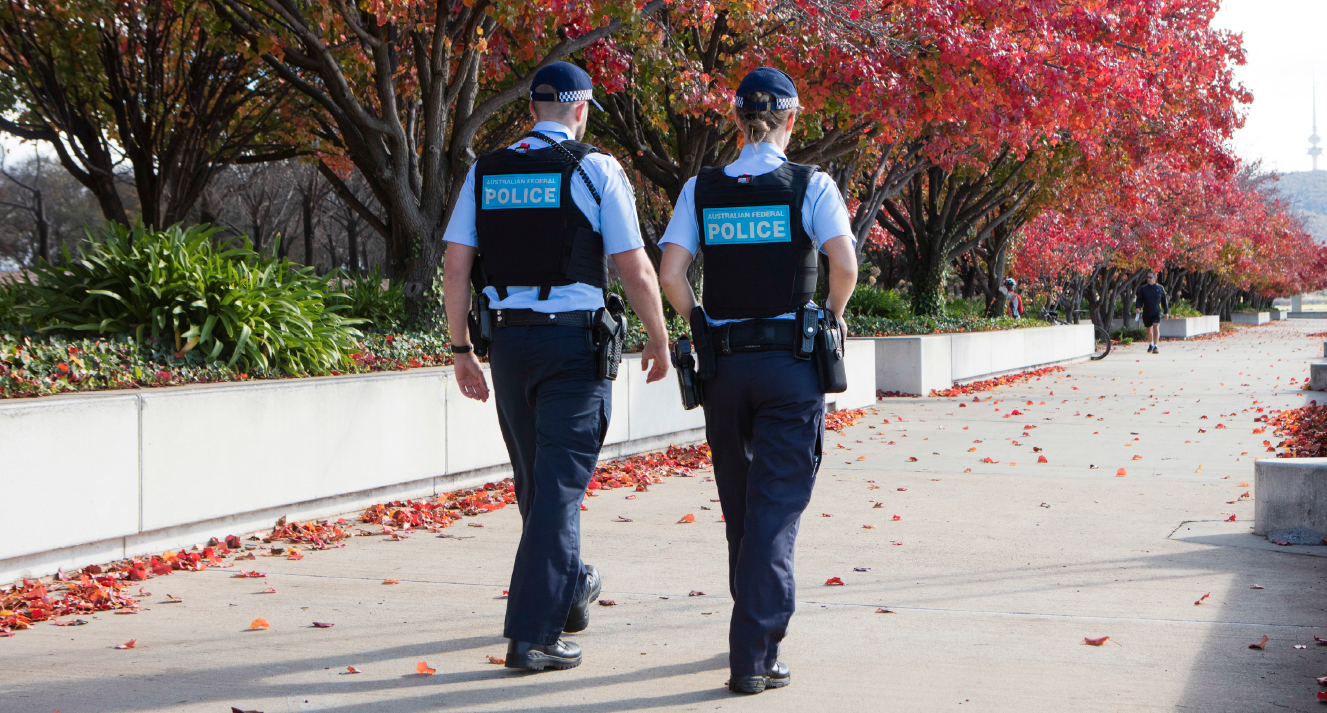
Appendix 1: Financial Statements
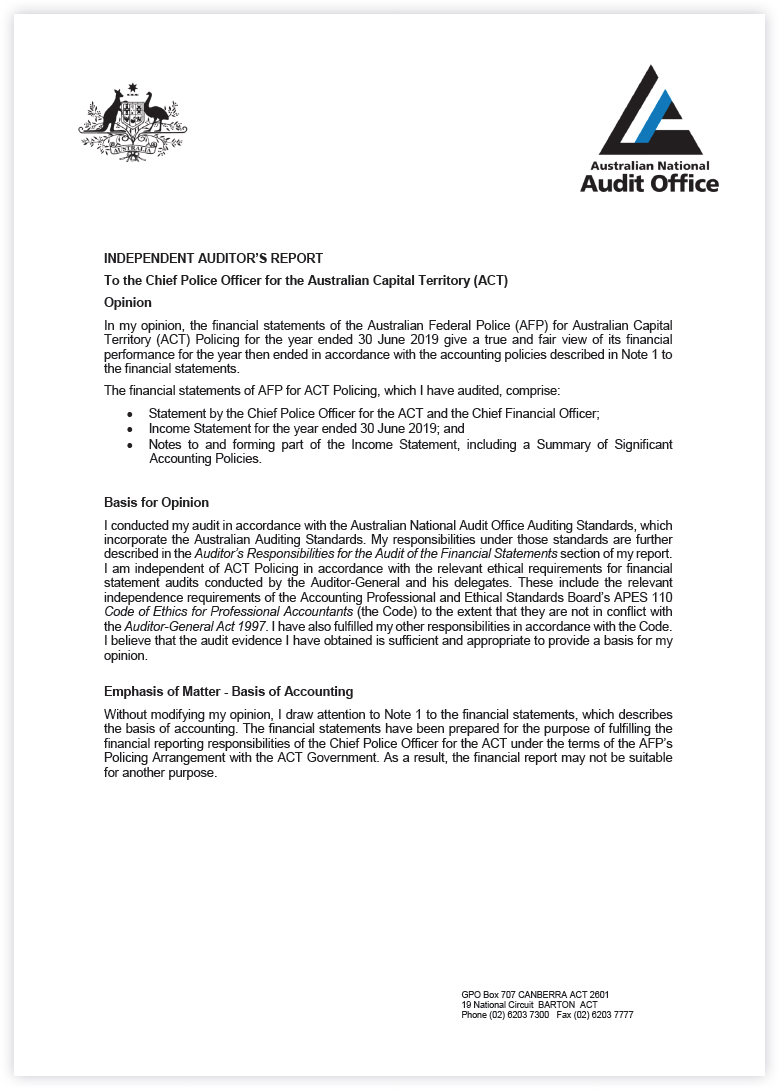
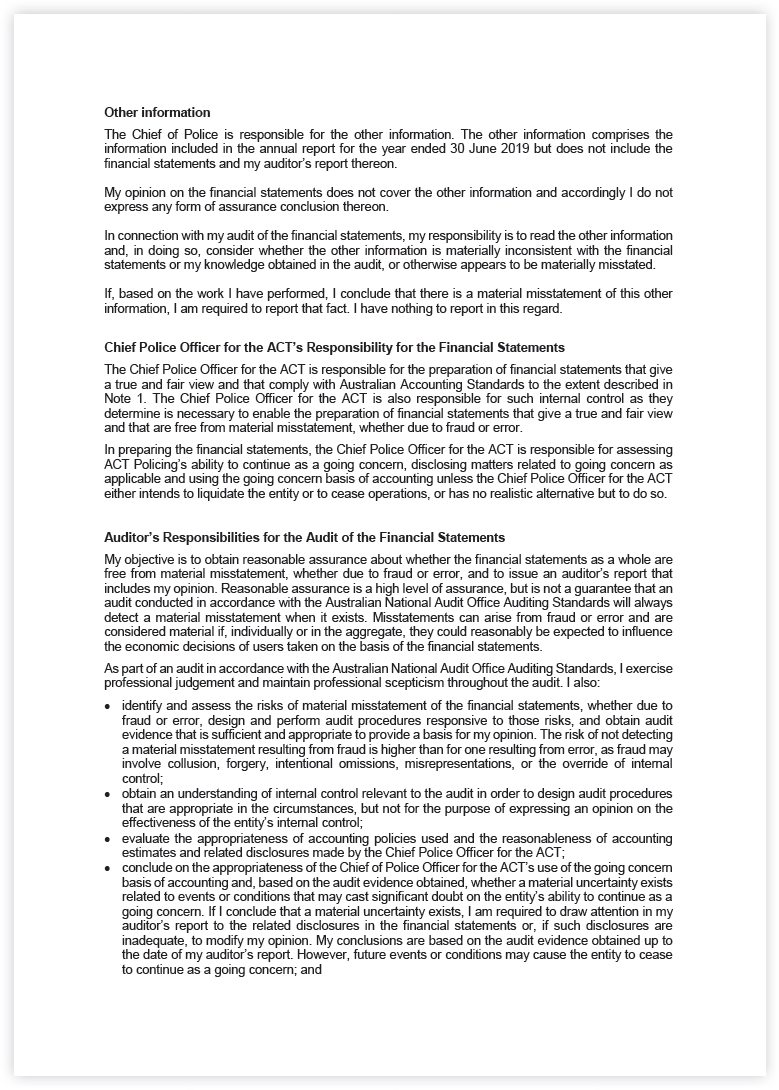


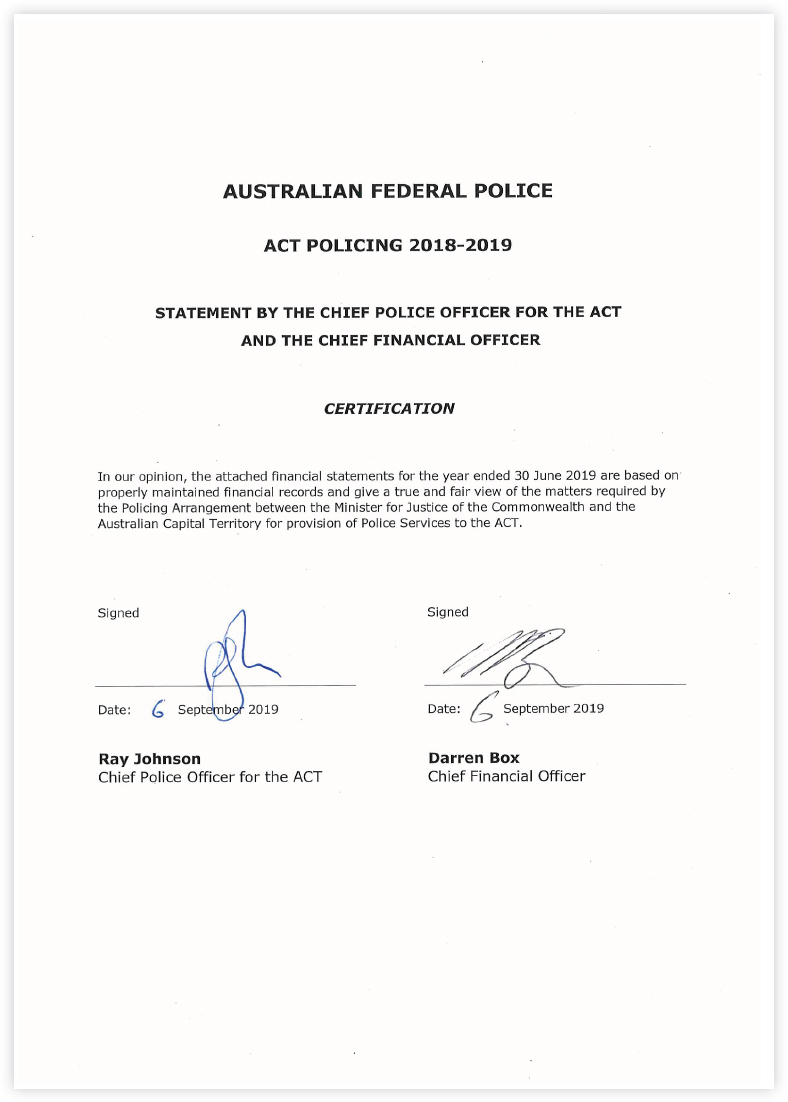
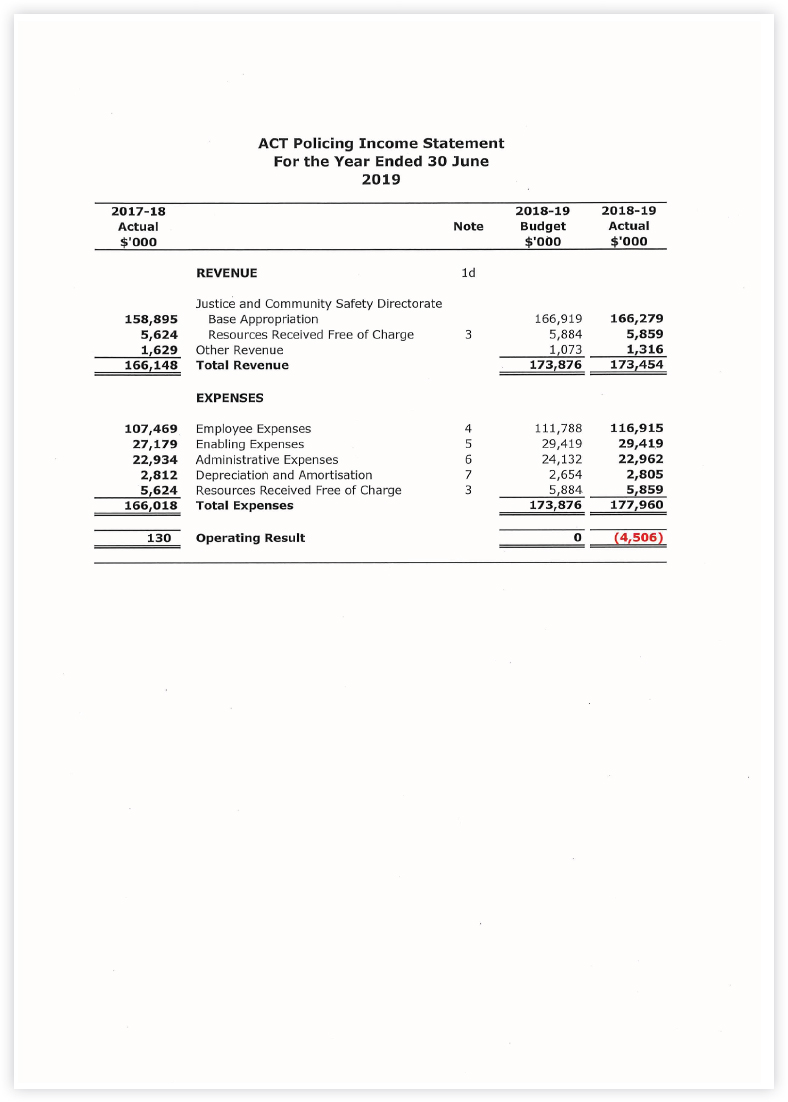
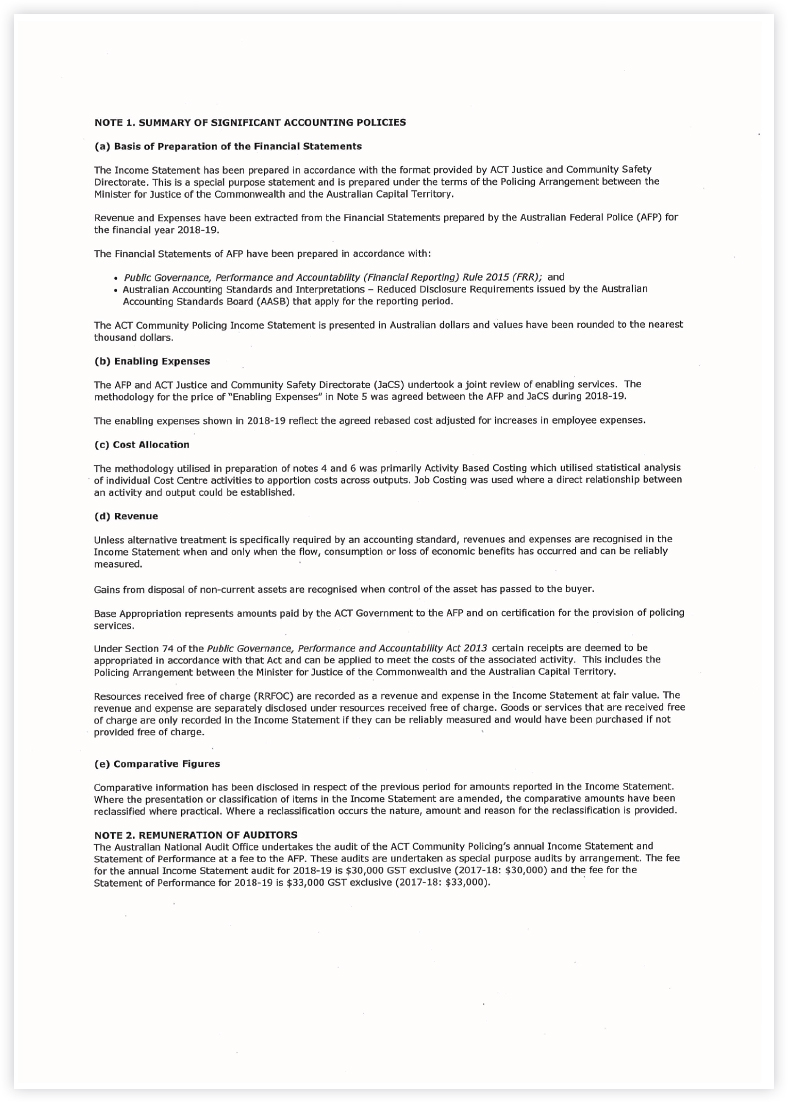
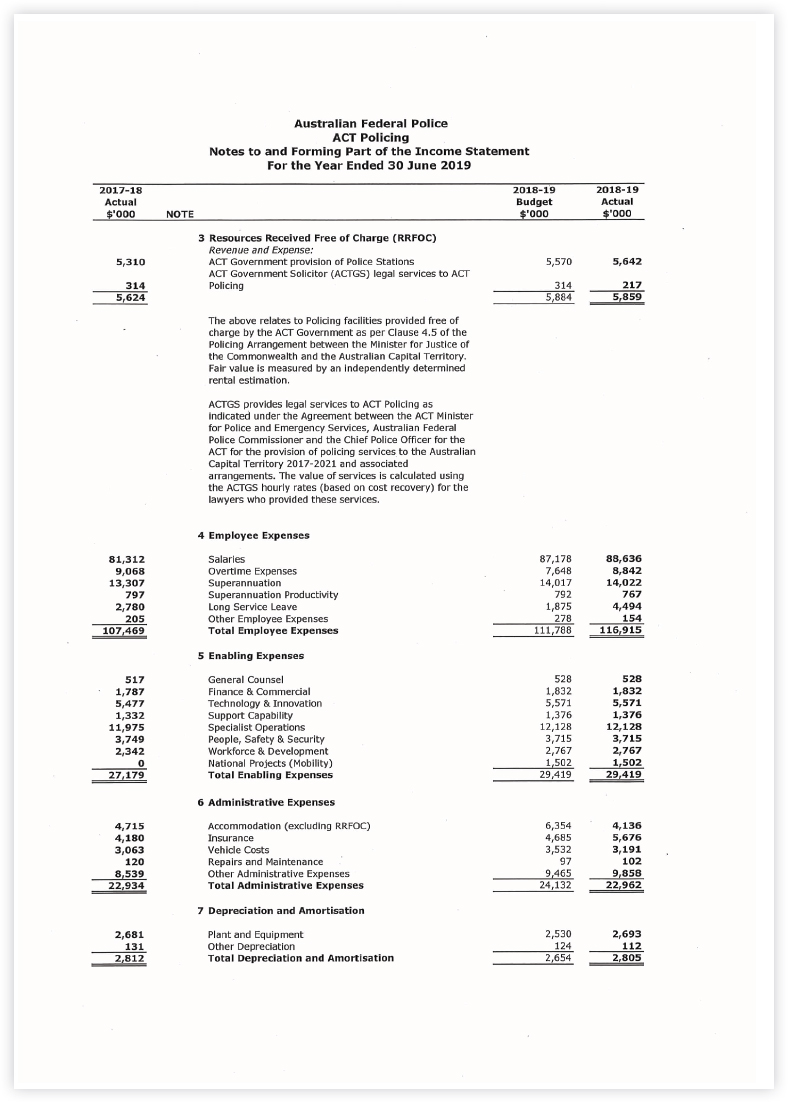
Appendix 2: Statement of Performance
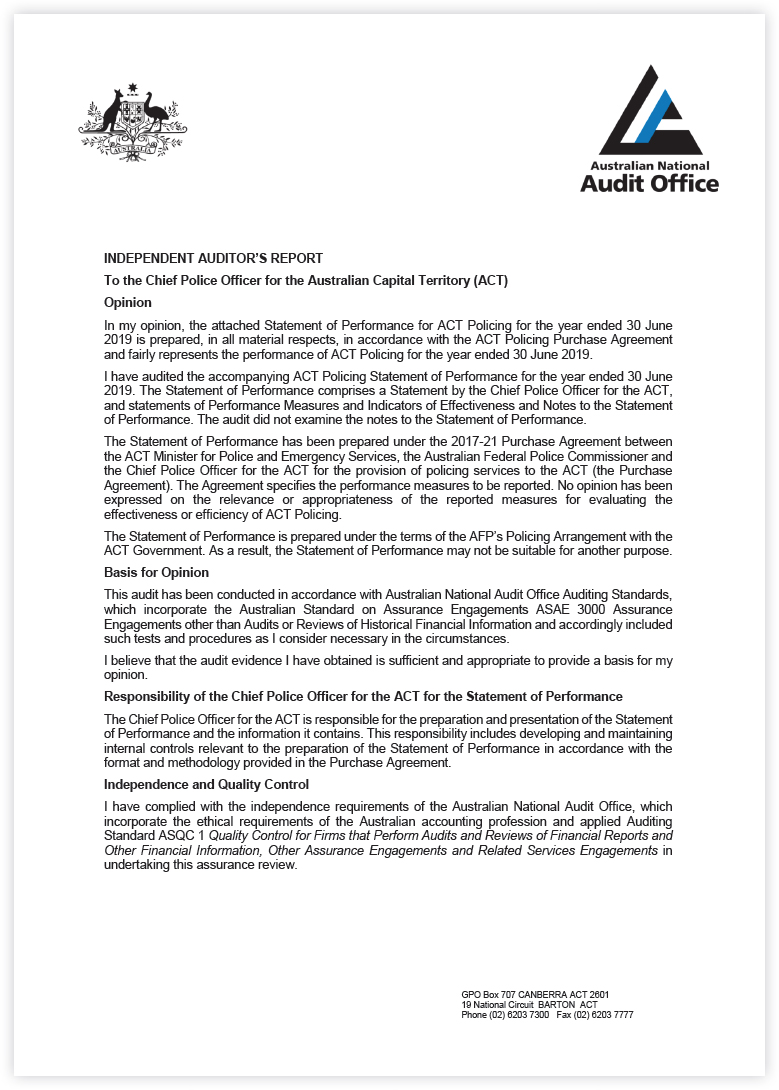
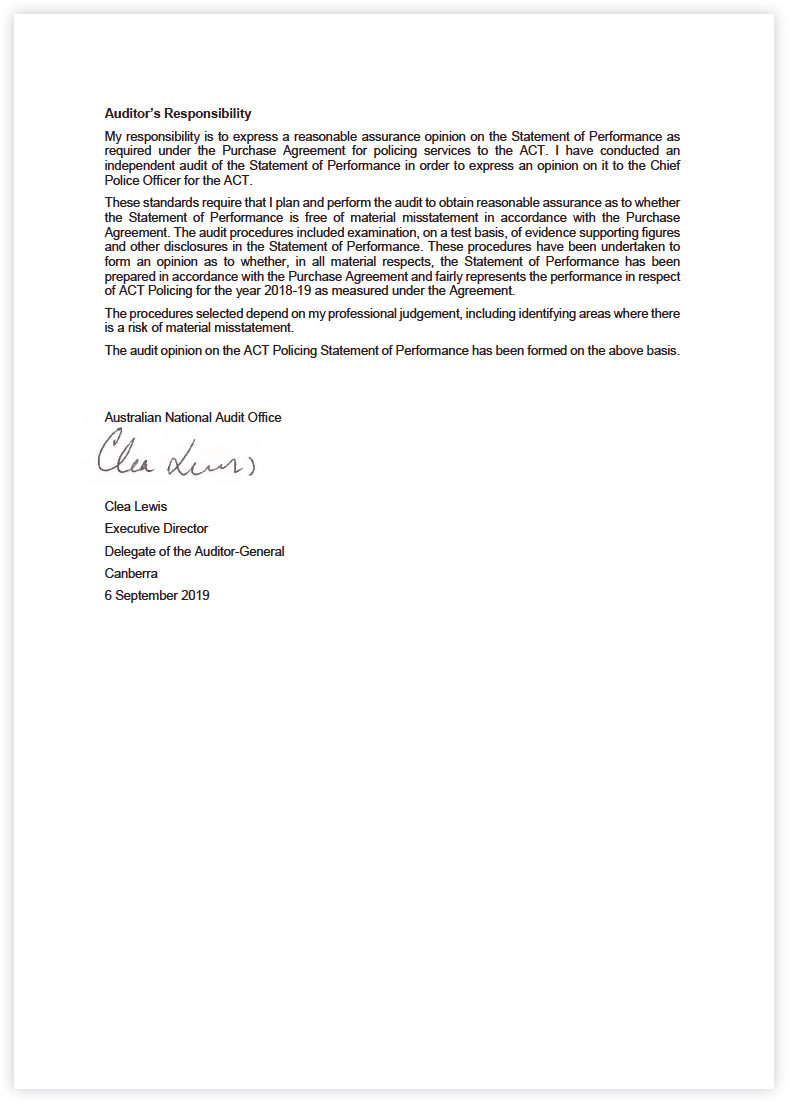
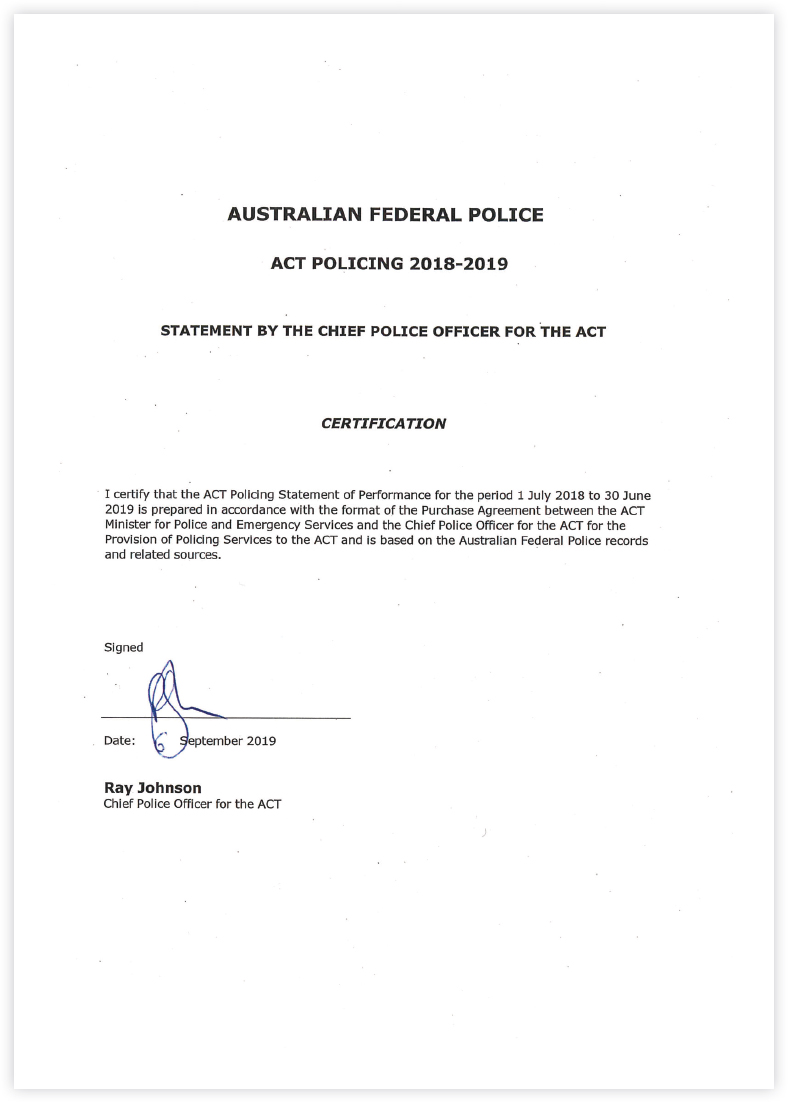
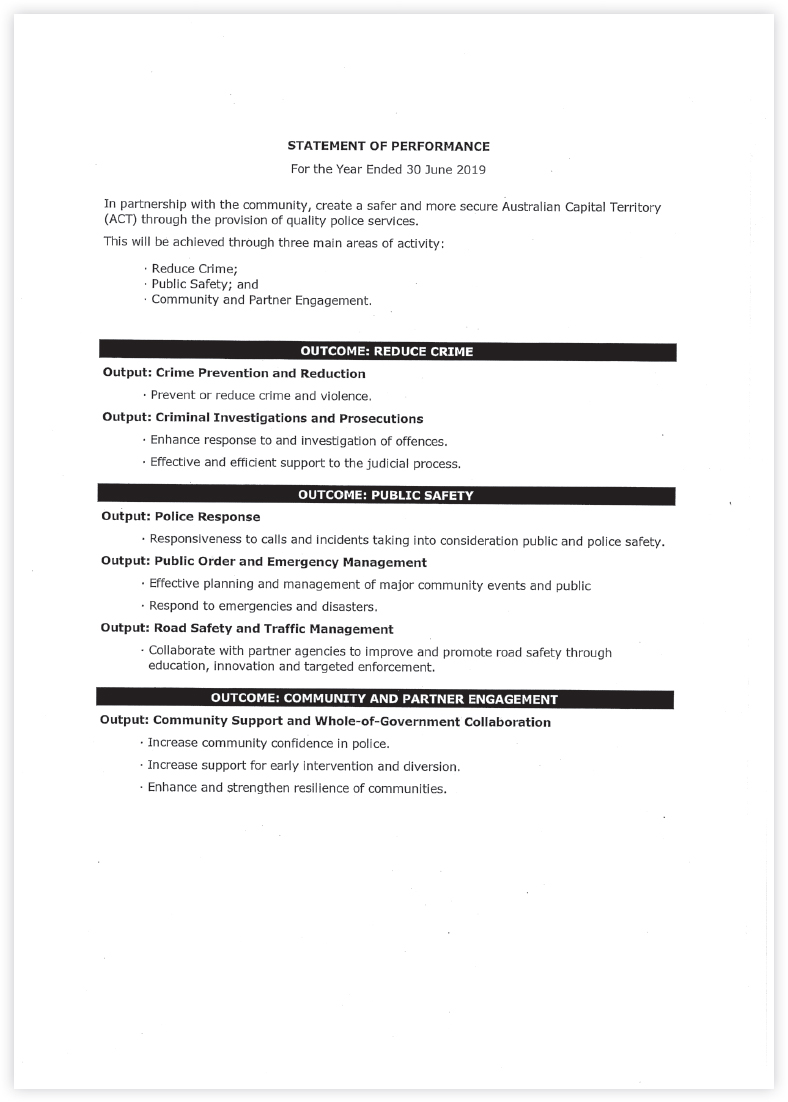
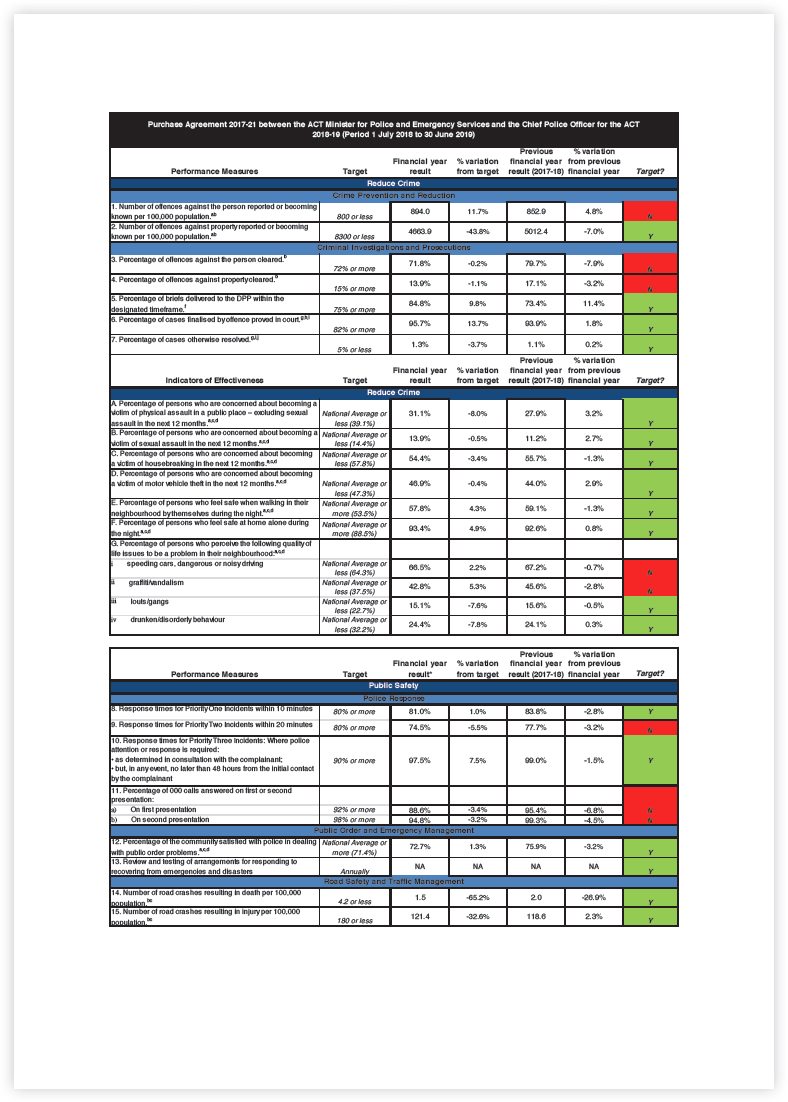
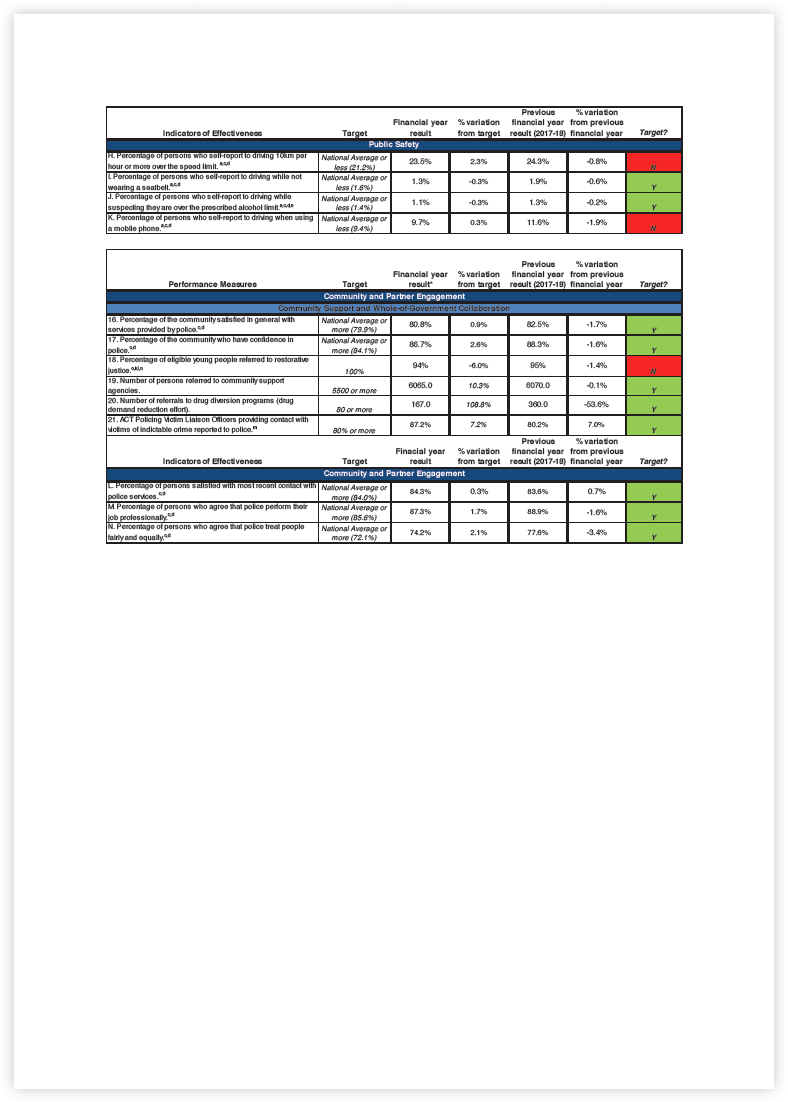
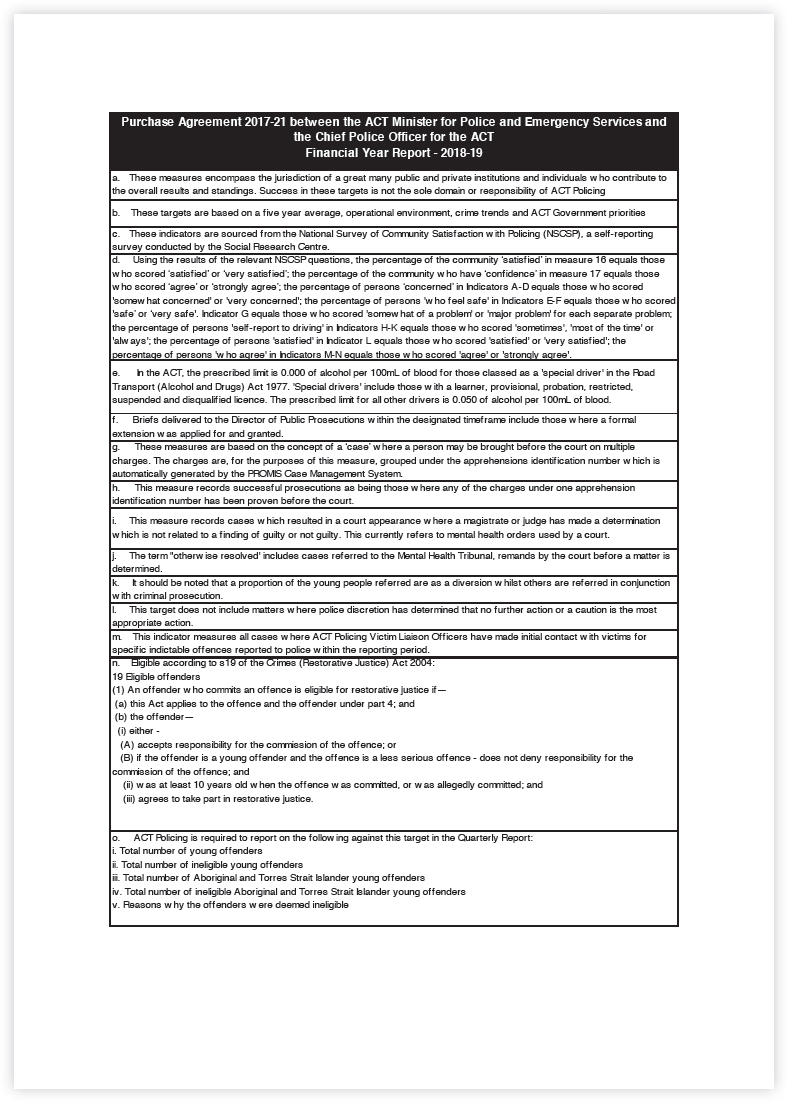
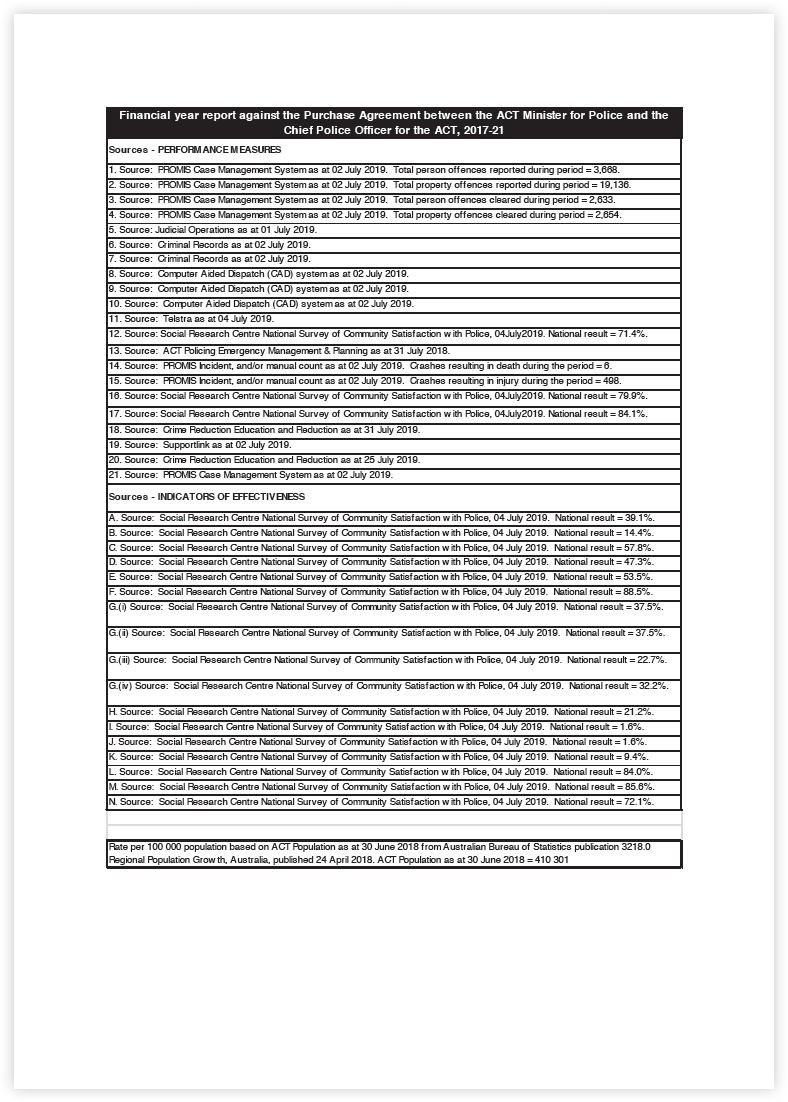
Appendix 3: Number of Offences Reported or Becoming Known in Australian Capital Territory 2014-15 to 2018-19
Offence type | 2014-15 | 2015-16 | 2016-17 | 2017-18 | 2018-19 |
|---|---|---|---|---|---|
OFFENCES AGAINST THE PERSON | |||||
Homicide and Related offences | |||||
Murder | 6 | 6 | 1 | 3 | - |
Attempted murder | - | 2 | 2 | 6 | 5 |
Conspiracy to murder | - | - | - | - | - |
Manslaughter | - | - | - | - | 1 |
Driving causing death | 1 | - | - | 2 | 1 |
Homicide unspecified | - | - | - | - | - |
Total Homicide and Related offences | 7 | 8 | 3 | 11 | 7 |
Assaults (excluding sexual) | |||||
Assault causing GBH | 28 | 67 | 77 | 93 | 115 |
Assault causing ABH | 302 | 368 | 472 | 430 | 432 |
Assault other | 1685 | 2123 | 2510 | 2314 | 2283 |
Total Assaults (excluding sexual) | 2015 | 2558 | 3059 | 2837 | 2830 |
Sexual Offences | |||||
Sexual assault 1st 2nd 3rd degree | 10 | 19 | 15 | 8 | 20 |
Sexual intercourse, no consent | 92 | 108 | 158 | 154 | 156 |
Sexual intercourse, person <16 yrs | 65 | 59 | 75 | 64 | 74 |
Indecent act, assault | 42 | 53 | 65 | 52 | 53 |
Indecent act, no consent | 60 | 99 | 117 | 106 | 115 |
Indecent act, person <16 yrs | 134 | 81 | 95 | 68 | 82 |
Incest | 8 | 24 | 10 | 3 | 13 |
Indecent exposure | 36 | 39 | 31 | 44 | 35 |
Total Sexual Assault Offences | 447 | 482 | 566 | 499 | 548 |
Other Offences | |||||
Kidnap/Abduction | 14 | 17 | 29 | 32 | 22 |
Other offences against the person | 96 | 235 | 327 | 194 | 261 |
Total Other Offences | 110 | 252 | 356 | 226 | 283 |
Total Offences against the Person | 2579 | 3300 | 3984 | 3573 | 3668 |
OFFENCES AGAINST PROPERTY | |||||
Robbery | |||||
Armed robbery | 111 | 78 | 136 | 123 | 100 |
Other robbery | 64 | 78 | 113 | 106 | 104 |
Total Robbery | 175 | 156 | 249 | 229 | 204 |
Blackmail and extortion | |||||
Blackmail and extortion | 3 | 6 | 18 | 15 | 14 |
Total Blackmail and Extortion | 3 | 6 | 18 | 15 | 14 |
Burglary | |||||
Burglary dwellings | 1552 | 1476 | 1647 | 1678 | 1612 |
Burglary shops | 267 | 432 | 335 | 287 | 405 |
Burglary other | 579 | 724 | 581 | 589 | 535 |
Total Burglary | 2398 | 2632 | 2563 | 2554 | 2552 |
Fraud and Misappropriation | |||||
Fraud | 1417 | 1532 | 1401 | 1378 | 1567 |
Misappropriation | - | 1 | - | - | 1 |
Counterfeiting | 32 | 38 | 32 | 60 | 40 |
Total Fraud and Misappropriation | 1449 | 1571 | 1433 | 1438 | 1608 |
Handling Stolen Goods | |||||
Receiving | 17 | 11 | 7 | 9 | 3 |
Unlawful possession | 129 | 147 | 106 | 168 | 86 |
Other handling stolen goods | 49 | 9 | 11 | 9 | 10 |
Total Handling of Stolen Goods | 195 | 167 | 124 | 186 | 99 |
Theft or Illegal use of a Vehicle | |||||
Motor vehicle theft | 1045 | 1034 | 1323 | 1484 | 1209 |
Total Theft or Illegal use of a Vehicle | 1045 | 1034 | 1323 | 1484 | 1209 |
Other Theft | |||||
Bicycle theft | 612 | 672 | 480 | 525 | 700 |
Boat theft | 4 | 1 | 2 | - | 1 |
Stock theft | 2 | 1 | - | 2 | - |
Shop stealing | 1050 | 1220 | 1336 | 1355 | 1175 |
Theft at burglary — dwellings | 863 | 775 | 1001 | 980 | 899 |
Theft at burglary — shops | 122 | 254 | 159 | 161 | 218 |
Theft at burglary — other | 300 | 374 | 267 | 318 | 261 |
Other theft | 7131 | 7678 | 6387 | 6442 | 5303 |
Total Other Theft | 10,084 | 10,975 | 9632 | 9783 | 8557 |
Property Damage | |||||
Arson | 151 | 178 | 211 | 230 | 227 |
Damage at burglary — dwellings | 112 | 163 | 131 | 131 | 127 |
Damage at burglary — shops | 23 | 38 | 37 | 36 | 58 |
Damage at burglary — other | 57 | 108 | 58 | 69 | 60 |
Other property damage | 4384 | 4634 | 4935 | 4178 | 4413 |
Total Property Damage | 4727 | 5121 | 5372 | 4644 | 4885 |
Environmental Offences | |||||
Pollution | 6 | 3 | 10 | 6 | 4 |
Flora and fauna | - | 1 | - | - | - |
Other environmental offences | 6 | 6 | 4 | 7 | 4 |
Total Environmental Offences | 12 | 10 | 14 | 13 | 8 |
Total Offences against Property | 20,088 | 21,672 | 20,728 | 20,346 | 19,136 |
OFFENCES AGAINST GOOD ORDER | |||||
Government security/operations | 42 | 62 | 103 | 67 | 59 |
Justice procedures | 1219 | 1407 | 1620 | 1874 | 1750 |
Firearms and weapons | 312 | 284 | 324 | 399 | 308 |
Other offences against good order | 1042 | 910 | 1010 | 898 | 916 |
Total Offences against Good Order | 2615 | 2663 | 3057 | 3238 | 3033 |
DRUG OFFENCES | |||||
Possess and use drugs | 550 | 541 | 638 | 784 | 507 |
Deal and supply drugs | 69 | 90 | 71 | 109 | 68 |
Manufacture and grow drugs | 41 | 21 | 18 | 16 | 15 |
Other drug offences | 25 | 30 | 23 | 44 | 32 |
Total Drug Offences | 685 | 682 | 750 | 953 | 622 |
TRAFFIC OFFENCES | |||||
Drink driving offences | 1105 | 959 | 912 | 1026 | 1063 |
Drug driving offences | 255 | 166 | 454 | 736 | 903 |
Dangerous and reckless driving | 155 | 138 | 132 | 144 | 168 |
Driving licence offences | 889 | 821 | 929 | 921 | 897 |
Other motor vehicle, traffic and related offences | 3126 | 3060 | 4078 | 3862 | 3410 |
Total Traffic Offences | 5530 | 5144 | 6505 | 6689 | 6441 |
OTHER OFFENCES NOT ELSE WHERE CLASSIFIED | |||||
Other offences n.e.c | 189 | 117 | 151 | 229 | 111 |
All Offences | 31,686 | 33,578 | 35,175 | 35,028 | 33,011 |
Continued | |||||
Appendix 4: Offences Cleared by ACT Policing in the Australian Capital Territory 2014-15 to 2018-19
Offence type | 2014-15 | 2015-16 | 2016-17 | 2017-18 | 2018-19 |
|---|---|---|---|---|---|
OFFENCES AGAINST THE PERSON | |||||
Homicide and Related offences | |||||
Murder | 5 | 2 | - | 5 | 1 |
Attempted murder | - | 1 | 2 | 4 | 5 |
Conspiracy to murder | - | - | - | - | - |
Manslaughter | - | - | - | - | 1 |
Driving causing death | 1 | - | - | 2 | 1 |
Homicide unspecified | - | - | - | - | - |
Total Homicide and Related offences | 6 | 3 | 2 | 11 | 8 |
Assaults (excluding sexual) | |||||
Assault causing GBH | 16 | 52 | 59 | 70 | 95 |
Assault causing ABH | 195 | 262 | 308 | 314 | 293 |
Assault other | 1153 | 1580 | 1913 | 1774 | 1657 |
Total Assaults (excluding sexual) | 1364 | 1894 | 2280 | 2158 | 2045 |
Sexual Offences | |||||
Sexual assault 1st 2nd 3rd degree | 5 | 11 | 11 | 10 | 12 |
Sexual intercourse, no consent | 55 | 70 | 96 | 118 | 119 |
Sexual intercourse, person < 16 yrs | 29 | 43 | 70 | 69 | 57 |
Indecent act, assault | 28 | 32 | 32 | 45 | 27 |
Indecent act, no consent | 25 | 70 | 65 | 83 | 83 |
Indecent act, person < 16 yrs | 87 | 116 | 80 | 69 | 67 |
Incest | 6 | 27 | 5 | 7 | 10 |
Indecent exposure | 14 | 9 | 5 | 23 | 20 |
Total Sexual Assault Offences | 249 | 378 | 364 | 424 | 395 |
Other Offences | |||||
Kidnap/Abduction | 8 | 12 | 29 | 26 | 17 |
Other offences against the person | 62 | 123 | 194 | 131 | 167 |
Total Other Offences | 70 | 135 | 223 | 157 | 184 |
Total Offences against the Person | 1689 | 2410 | 2869 | 2750 | 2632 |
OFFENCES AGAINST PROPERTY | |||||
Robbery | |||||
Armed robbery | 56 | 27 | 34 | 51 | 57 |
Other robbery | 18 | 34 | 40 | 41 | 36 |
Total Robbery | 74 | 61 | 74 | 92 | 93 |
Blackmail and extortion | |||||
Blackmail and extortion | - | 3 | 11 | 2 | 1 |
Total Blackmail and Extortion | - | 3 | 11 | 2 | 1 |
Burglary | |||||
Burglary dwellings | 145 | 130 | 125 | 181 | 133 |
Burglary shops | 17 | 36 | 29 | 31 | 45 |
Burglary other | 69 | 59 | 32 | 64 | 58 |
Total Burglary | 231 | 225 | 186 | 276 | 236 |
Fraud and Misappropriation | |||||
Fraud | 536 | 653 | 504 | 691 | 432 |
Misappropriation | - | - | - | - | 1 |
Counterfeiting | 2 | 1 | 1 | 26 | 1 |
Total Fraud and Misappropriation | 538 | 654 | 505 | 717 | 434 |
Handling Stolen Goods | |||||
Receiving | 14 | 7 | 2 | 15 | 2 |
Unlawful possession | 102 | 91 | 83 | 155 | 80 |
Other handling stolen goods | 45 | 7 | 8 | 5 | 11 |
Total Handling of Stolen Goods | 161 | 105 | 93 | 175 | 93 |
Theft or Illegal use of a Vehicle | |||||
Motor vehicle theft | 99 | 127 | 149 | 196 | 153 |
Total Theft or Illegal use of a Vehicle | 99 | 127 | 149 | 196 | 153 |
Other Theft | |||||
Bicycle theft | 9 | 9 | 15 | 13 | 14 |
Boat theft | - | 1 | - | - | - |
Stock theft | - | - | - | - | - |
Shop stealing | 320 | 431 | 465 | 492 | 341 |
Theft at burglary — dwellings | 83 | 65 | 56 | 97 | 52 |
Theft at burglary — shops | 11 | 20 | 16 | 14 | 24 |
Theft at burglary — other | 32 | 35 | 8 | 9 | 13 |
Other theft | 640 | 705 | 568 | 527 | 462 |
Total Other Theft | 1095 | 1266 | 1128 | 1152 | 906 |
Property Damage | |||||
Arson | 13 | 28 | 14 | 18 | 12 |
Damage at burglary — dwellings | 14 | 26 | 25 | 19 | 33 |
Damage at burglary — shops | 1 | 4 | 2 | 6 | 5 |
Damage at burglary — other | 13 | 26 | 5 | 4 | 7 |
Other property damage | 566 | 627 | 786 | 733 | 677 |
Total Property Damage | 607 | 711 | 832 | 780 | 734 |
Environmental Offences | |||||
Pollution | 4 | 2 | 7 | 5 | 2 |
Flora and fauna | - | - | - | - | - |
Other environmental offences | 3 | 6 | 2 | 5 | 2 |
Total Environmental Offences | 7 | 8 | 9 | 10 | 4 |
Total Offences against Property | 2812 | 3160 | 2987 | 3400 | 2654 |
OFFENCES AGAINST GOOD ORDER | |||||
Government security/operations | 34 | 53 | 100 | 65 | 62 |
Justice procedures | 1021 | 1166 | 1411 | 1644 | 1474 |
Firearms and weapons | 222 | 231 | 277 | 281 | 283 |
Other offences against good order | 705 | 615 | 675 | 629 | 650 |
Total Offences against Good Order | 1982 | 2065 | 2463 | 2619 | 2469 |
DRUG OFFENCES | |||||
Possess and use drugs | 415 | 431 | 522 | 638 | 434 |
Deal and supply drugs | 46 | 55 | 58 | 85 | 92 |
Manufacture and grow drugs | 20 | 14 | 15 | 10 | 11 |
Other drug offences | 8 | 11 | 6 | 11 | 9 |
Total Drug Offences | 489 | 511 | 601 | 744 | 546 |
TRAFFIC OFFENCES | |||||
Drink driving offences | 1025 | 895 | 807 | 978 | 1028 |
Drug driving offences | 242 | 170 | 436 | 695 | 935 |
Dangerous and reckless driving | 121 | 116 | 97 | 99 | 126 |
Driving licence offences | 810 | 763 | 832 | 872 | 857 |
Other motor vehicle, traffic and related offences | 2386 | 2290 | 2556 | 2360 | 1963 |
Total Traffic Offences | 4584 | 4234 | 4728 | 5004 | 4909 |
OTHER OFFENCES NOT ELSE WHERE CLASSIFIED | |||||
Other offences n.e.c | 95 | 52 | 50 | 79 | 57 |
All Offences | 11,651 | 12,432 | 13,698 | 14,596 | 13,267 |
Continued | |||||
Appendix 5: Percentage of Offences Cleared by ACT Policing 2014-15 to 2018-19
Offence type | 2014-15 | 2015-16 | 2016-17 | 2017-18 | 2018-19 |
|---|---|---|---|---|---|
OFFENCES AGAINST THE PERSON | |||||
Homicide and Related offences | |||||
Murder | 83.3% | 33.3% | 0.0% | 166.7% | 100.0% |
Attempted murder | 0.0% | 50.0% | 100.0% | 66.7% | 100.0% |
Conspiracy to murder | 0.0% | 0.0% | 0.0% | 0.0% | 0.0% |
Manslaughter | 0.0% | 0.0% | 0.0% | 0.0% | 100.0% |
Driving causing death | 100.0% | 0.0% | 0.0% | 100.0% | 100.0% |
Homicide unspecified | 0.0% | 0.0% | 0.0% | 0.0% | 0.0% |
Total Homicide and Related offences | 85.7% | 37.5% | 66.7% | 100.0% | 114.3% |
Assaults (excluding sexual) | |||||
Assault causing GBH | 57.1% | 77.6% | 76.6% | 75.3% | 82.6% |
Assault causing ABH | 64.6% | 71.2% | 65.3% | 73.0% | 67.8% |
Assault other | 68.4% | 74.4% | 76.2% | 76.7% | 72.6% |
Total Assaults (excluding sexual) | 67.7% | 74.0% | 74.5% | 76.1% | 72.3% |
Sexual Offences | |||||
Sexual assault 1st 2nd 3rd degree | 50.0% | 57.9% | 73.3% | 125.0% | 60.0% |
Sexual intercourse, no consent | 59.8% | 64.8% | 60.8% | 76.6% | 76.3% |
Sexual intercourse, person <16 yrs | 44.6% | 72.9% | 93.3% | 107.8% | 77.0% |
Indecent act, assault | 66.7% | 60.4% | 49.2% | 86.5% | 50.9% |
Indecent act, no consent | 41.7% | 70.7% | 55.6% | 78.3% | 72.2% |
Indecent act, person <16 yrs | 64.9% | 143.2% | 84.2% | 101.5% | 81.7% |
Incest | 75.0% | 112.5% | 50.0% | 233.3% | 76.9% |
Indecent exposure | 38.9% | 23.1% | 16.1% | 52.3% | 57.1% |
Total Sexual Assault Offences | 55.7% | 78.4% | 64.3% | 85.0% | 72.1% |
Other Offences | |||||
Kidnap/Abduction | 57.1% | 70.6% | 100.0% | 81.3% | 77.3% |
Other offences against the person | 64.6% | 52.3% | 59.3% | 67.5% | 64.0% |
Total Other Offences | 63.6% | 53.6% | 62.6% | 69.5% | 65.0% |
Total Offences against the Person | 65.5% | 73.0% | 72.0% | 77.0% | 71.8% |
OFFENCES AGAINST PROPERTY | |||||
Robbery | |||||
Armed robbery | 50.5% | 34.6% | 25.0% | 41.5% | 57.0% |
Other robbery | 28.1% | 43.6% | 35.4% | 38.7% | 34.6% |
Total Robbery | 42.3% | 39.1% | 29.7% | 40.2% | 45.6% |
Blackmail and extortion | |||||
Blackmail and extortion | 0.0% | 50.0% | 61.1% | 13.3% | 7.1% |
Total Blackmail and Extortion | 0.0% | 50.0% | 61.1% | 13.3% | 7.1% |
Burglary | |||||
Burglary dwellings | 9.3% | 8.8% | 7.6% | 10.8% | 8.3% |
Burglary shops | 6.4% | 8.3% | 8.7% | 10.8% | 11.1% |
Burglary other | 11.9% | 8.1% | 5.5% | 10.9% | 10.8% |
Total Burglary | 9.6% | 8.5% | 7.3% | 10.8% | 9.2% |
Fraud and Misappropriation | |||||
Fraud | 37.8% | 42.6% | 36.0% | 50.1% | 27.6% |
Misappropriation | 0.0% | 0.0% | 0.0% | 0.0% | 100.0% |
Counterfeiting | 6.3% | 2.6% | 3.1% | 43.3% | 2.5% |
Total Fraud and Misappropriation | 37.1% | 41.6% | 35.2% | 49.9% | 27.0% |
Handling Stolen Goods | |||||
Receiving | 82.4% | 63.6% | 28.6% | 166.7% | 66.7% |
Unlawful possession | 79.1% | 61.9% | 78.3% | 92.3% | 93.0% |
Other handling stolen goods | 91.8% | 77.8% | 72.7% | 55.6% | 110.0% |
Total Handling of Stolen Goods | 82.6% | 62.9% | 75.0% | 94.1% | 93.9% |
Theft or Illegal use of a Vehicle | |||||
Motor vehicle theft | 9.5% | 12.3% | 11.3% | 13.2% | 12.7% |
Total Theft or Illegal use of a Vehicle | 9.5% | 12.3% | 11.3% | 13.2% | 12.7% |
Other Theft | |||||
Bicycle theft | 1.5% | 1.3% | 3.1% | 2.5% | 2.0% |
Boat theft | 0.0% | 100.0% | 0.0% | 0.0% | 0.0% |
Stock theft | 0.0% | 0.0% | 0.0% | 0.0% | 0.0% |
Shop stealing | 30.5% | 35.3% | 34.8% | 36.3% | 29.0% |
Theft at burglary — dwellings | 9.6% | 8.4% | 5.6% | 9.9% | 5.8% |
Theft at burglary — shops | 9.0% | 7.9% | 10.1% | 8.7% | 11.0% |
Theft at burglary — other | 10.7% | 9.4% | 3.0% | 2.8% | 5.0% |
Other theft | 9.0% | 9.2% | 8.9% | 8.2% | 8.7% |
Total Other Theft | 10.9% | 11.5% | 11.7% | 11.8% | 10.6% |
Property Damage | |||||
Arson | 8.6% | 15.7% | 6.6% | 7.8% | 5.3% |
Damage at burglary — dwellings | 12.5% | 16.0% | 19.1% | 14.5% | 26.0% |
Damage at burglary — shops | 4.3% | 10.5% | 5.4% | 16.7% | 8.6% |
Damage at burglary — other | 22.8% | 24.1% | 8.6% | 5.8% | 11.7% |
Other property damage | 12.9% | 13.5% | 15.9% | 17.5% | 15.3% |
Total Property Damage | 12.8% | 13.9% | 15.5% | 16.8% | 15.0% |
Environmental Offences | |||||
Pollution | 66.7% | 66.7% | 70.0% | 83.3% | 50.0% |
Flora and fauna | 0.0% | 0.0% | 0.0% | 0.0% | 0.0% |
Other environmental offences | 50.0% | 100.0% | 50.0% | 71.4% | 50.0% |
Total Environmental Offences | 58.3% | 80.0% | 64.3% | 76.9% | 50.0% |
Total Offences against Property | 14.0% | 14.6% | 14.4% | 16.7% | 13.9% |
OFFENCES AGAINST GOOD ORDER | |||||
Government security/operations | 81.0% | 85.5% | 97.1% | 97.0% | 105.1% |
Justice procedures | 83.8% | 82.9% | 87.1% | 87.7% | 84.2% |
Firearms and weapons | 71.2% | 81.3% | 85.5% | 70.4% | 91.9% |
Other offences against good order | 67.7% | 67.6% | 66.8% | 70.0% | 71.0% |
Total Offences against Good Order | 75.8% | 77.5% | 80.6% | 80.9% | 81.4% |
DRUG OFFENCES | |||||
Possess and use drugs | 75.5% | 79.7% | 81.8% | 81.4% | 85.6% |
Deal and supply drugs | 66.7% | 61.1% | 81.7% | 78.0% | 135.3% |
Manufacture and grow drugs | 48.8% | 66.7% | 83.3% | 62.5% | 73.3% |
Other drug offences | 32.0% | 36.7% | 26.1% | 25.0% | 28.1% |
Total Drug Offences | 71.4% | 74.9% | 80.1% | 78.1% | 87.8% |
TRAFFIC OFFENCES | |||||
Drink driving offences | 92.8% | 93.3% | 88.5% | 95.3% | 96.7% |
Drug driving offences | 94.9% | 102.4% | 96.0% | 94.4% | 103.5% |
Dangerous and reckless driving | 78.1% | 84.1% | 73.5% | 68.8% | 75.0% |
Driving licence offences | 91.1% | 92.9% | 89.6% | 94.7% | 95.5% |
Other motor vehicle, traffic and related offences | 76.3% | 74.8% | 62.7% | 61.1% | 57.6% |
Total Traffic Offences | 82.9% | 82.3% | 72.7% | 74.8% | 76.2% |
OTHER OFFENCES NOT ELSE WHERE CLASSIFIED | |||||
Other offences n.e.c | 50.3% | 44.4% | 33.1% | 34.5% | 51.4% |
All Offences | 36.8% | 37.0% | 38.9% | 41.7% | 40.2% |
Continued | |||||
Appendix 6: Proceedings Against Offenders by ACT Policing (Charges) 2014-15 to 2018-19
Offence type | 2014-15 | 2015-16 | 2016-17 | 2017-18 | 2018-19 |
|---|---|---|---|---|---|
OFFENCES AGAINST THE PERSON | |||||
Homicide and Related offences | |||||
Murder | 5 | 3 | 2 | 7 | 5 |
Attempted murder | - | 1 | 2 | 4 | 9 |
Conspiracy to murder | - | - | - | - | - |
Manslaughter | - | - | - | - | 1 |
Driving causing death | - | 1 | 1 | 3 | 1 |
Homicide unspecified | 2 | - | - | - | - |
Total Homicide and Related offences | 7 | 5 | 5 | 14 | 16 |
Assaults (excluding sexual) | |||||
Assault causing GBH | 31 | 100 | 102 | 128 | 155 |
Assault causing ABH | 208 | 284 | 303 | 316 | 311 |
Assault other | 730 | 934 | 1043 | 975 | 912 |
Total Assaults (excluding sexual) | 969 | 1318 | 1448 | 1419 | 1378 |
Sexual Offences | |||||
Sexual assault 1st 2nd 3rd degree | 6 | 13 | 25 | 7 | 21 |
Sexual intercourse, no consent | 25 | 46 | 32 | 27 | 23 |
Sexual intercourse, person <16 yrs | 33 | 55 | 37 | 21 | 26 |
Indecent act, assault | 6 | 3 | 2 | 2 | - |
Indecent act, no consent | 22 | 98 | 61 | 79 | 33 |
Indecent act, person <16 yrs | 120 | 95 | 74 | 53 | 46 |
Incest | 9 | 25 | 13 | 1 | 14 |
Indecent exposure | 8 | 8 | 5 | 6 | 11 |
Total Sexual Assault Offences | 229 | 343 | 249 | 196 | 174 |
Other Offences | |||||
Kidnap/Abduction | 18 | 23 | 46 | 33 | 29 |
Other offences against the person | 115 | 192 | 240 | 201 | 212 |
Total Other Offences | 133 | 215 | 286 | 234 | 241 |
Total Offences against the Person | 1338 | 1881 | 1988 | 1863 | 1809 |
OFFENCES AGAINST PROPERTY | |||||
Robbery | |||||
Armed robbery | 63 | 48 | 53 | 55 | 98 |
Other robbery | 27 | 28 | 90 | 86 | 54 |
Total Robbery | 90 | 76 | 143 | 141 | 152 |
Blackmail and extortion | |||||
Blackmail and extortion | 3 | 3 | 18 | 5 | 8 |
Total Blackmail and Extortion | 3 | 3 | 18 | 5 | 8 |
Burglary | |||||
Burglary dwellings | 197 | 163 | 129 | 194 | 190 |
Burglary shops | 30 | 61 | 39 | 46 | 51 |
Burglary other | 101 | 88 | 59 | 108 | 115 |
Total Burglary | 328 | 312 | 227 | 348 | 356 |
Fraud and Misappropriation | |||||
Fraud | 723 | 649 | 836 | 705 | 307 |
Misappropriation | - | - | - | - | - |
Counterfeiting | - | - | 2 | - | 1 |
Total Fraud and Misappropriation | 723 | 649 | 838 | 705 | 308 |
Handling Stolen Goods | |||||
Receiving | 19 | 42 | 25 | 35 | 8 |
Unlawful possession | 291 | 245 | 262 | 282 | 171 |
Other handling stolen goods | 1 | - | 4 | 11 | 4 |
Total Handling of Stolen Goods | 311 | 287 | 291 | 328 | 183 |
Theft or Illegal use of a Vehicle | |||||
Motor vehicle theft | 156 | 162 | 215 | 299 | 310 |
Total Theft or Illegal use of a Vehicle | 156 | 162 | 215 | 299 | 310 |
Other Theft | |||||
Bicycle theft | 11 | 29 | 12 | 10 | 15 |
Boat theft | - | - | - | - | - |
Stock theft | - | 2 | - | - | - |
Shop stealing | 256 | 341 | 285 | 239 | 261 |
Theft at burglary — dwellings | 64 | 141 | 63 | 87 | 73 |
Theft at burglary — shops | 15 | 26 | 16 | 13 | 26 |
Theft at burglary — other | 44 | 28 | 8 | 23 | 34 |
Other theft | 305 | 411 | 459 | 300 | 222 |
Total Other Theft | 695 | 978 | 843 | 672 | 631 |
Property Damage | |||||
Arson | 19 | 29 | 10 | 22 | 25 |
Damage at burglary — dwellings | 39 | 108 | 34 | 37 | 48 |
Damage at burglary — shops | 12 | 9 | 7 | 6 | 12 |
Damage at burglary — other | 34 | 15 | 20 | 18 | 42 |
Other property damage | 447 | 491 | 536 | 538 | 538 |
Total Property Damage | 551 | 652 | 607 | 621 | 665 |
Environmental Offences | |||||
Pollution | 3 | - | 4 | 4 | - |
Flora and fauna | - | - | - | 1 | - |
Other environmental offences | 2 | 2 | 1 | 1 | 1 |
Total Environmental Offences | 5 | 2 | 5 | 6 | 1 |
Total Offences against Property | 2862 | 3121 | 3187 | 3125 | 2614 |
OFFENCES AGAINST GOOD ORDER | |||||
Government security/operations | 106 | 158 | 216 | 182 | 107 |
Justice procedures | 1747 | 1919 | 2142 | 2454 | 2384 |
Firearms and weapons | 395 | 335 | 392 | 420 | 465 |
Other offences against good order | 633 | 504 | 568 | 575 | 550 |
Total Offences against Good Order | 2881 | 2916 | 3318 | 3631 | 3506 |
DRUG OFFENCES | |||||
Possess and use drugs | 500 | 546 | 646 | 728 | 506 |
Deal and supply drugs | 124 | 86 | 142 | 250 | 160 |
Manufacture and grow drugs | 74 | 34 | 31 | 21 | 24 |
Other drug offences | 2 | - | 1 | 1 | 1 |
Total Drug Offences | 700 | 666 | 820 | 1000 | 691 |
TRAFFIC OFFENCES | |||||
Drink driving offences | 1194 | 1030 | 922 | 1060 | 1153 |
Drug driving offences | 450 | 347 | 637 | 816 | 1010 |
Dangerous and reckless driving | 134 | 180 | 120 | 162 | 152 |
Driving licence offences | 1056 | 1016 | 1248 | 1255 | 1195 |
Other motor vehicle, traffic and related offences | 1480 | 1289 | 1506 | 1430 | 1306 |
Total Traffic Offences | 4314 | 3862 | 4433 | 4723 | 4816 |
OTHER OFFENCES NOT ELSE WHERE CLASSIFIED | |||||
Other offences n.e.c | 95 | 50 | 72 | 251 | 105 |
All Offences | 12,190 | 12,496 | 13,818 | 14,593 | 13,541 |
Continued | |||||

 Translate
Translate



